Northern Ontario's Quetico Provincial Park is known for its beautiful wilderness. We’ve stayed at the campground a few times now, here's our review and comprehensive visitor guide!
Originally published September 24, 2023. Updated 5/27/2025.

I’ve been learning more and more about my family history in the past few years, and have done a lot of reading about my great great grandmother’s history, living in the boundary waters canoe area wilderness.
She was kicked off her reservation - the Anishinaabe community of Lac La Croix - after marrying a white guy, and the two of them ended up living off the land, raising their kids in the general area of Quetico.
I ended up meeting a distant cousin of mine in a group for Aurora Borealis chasers, and it’s been interesting to learn about her life in Gakijiwanong Anishinaabe Nation, (formerly known as Lac La Croix).
She invited me to come visit for their traditional pow wow earlier that year, but we’re putting that off until things calm down. Definitely looking forward to meeting her!
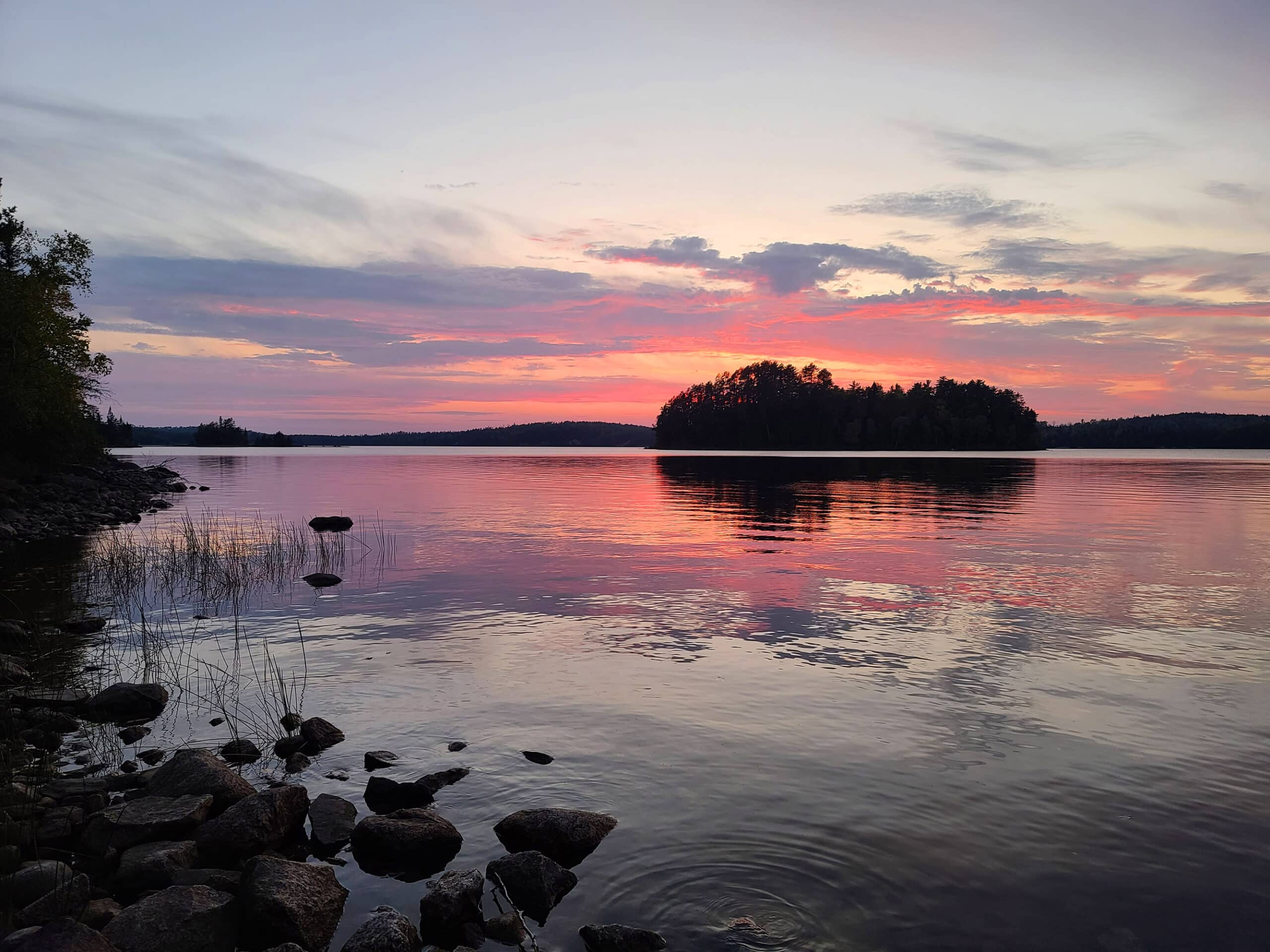
It was also very cool to share the same *local* conditions when it came to the weather, and the aurora, given how we met.
The timing was amazing, as the northern lights ERUPTED on our first night in the park. Despite all of our attempts in chasing them - in previous years, and along that whole trip - it ended up being my first time seeing them.
Maybe I’m being weirdly sentimental, but it felt special for that to be my first sighting - like they’d waited until I was in my family’s ancestral home.
On our second visit, we got an even BIGGER aurora show! So, I’m now half-convinced it’s the ancestors welcoming me home.
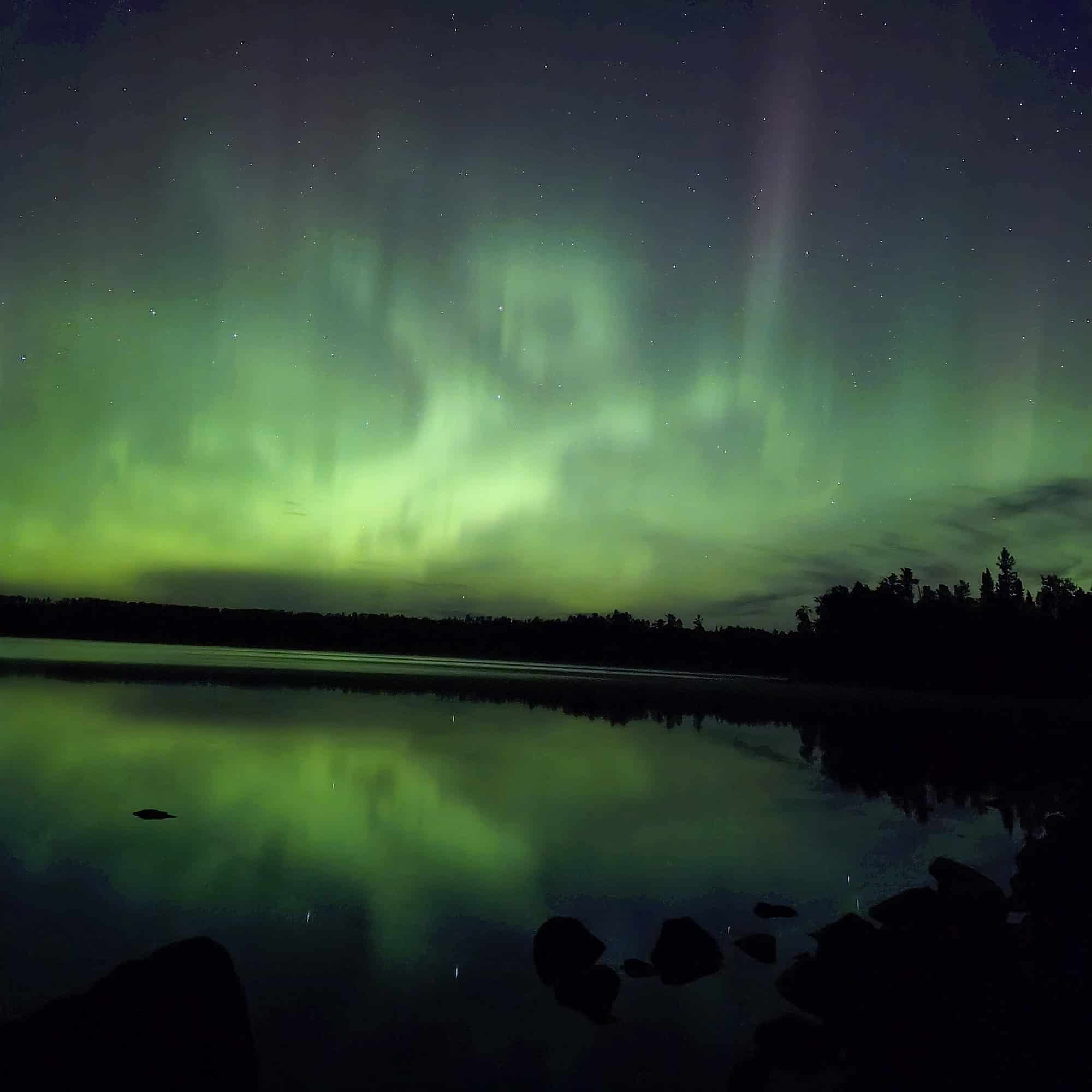
So... About Quetico
Anyway, we had an amazing time at Quetico, which is a HUGE provincial park in Northwestern Ontario.
This is definitely the biggest, most remote park we’ve been to. It’s roughly 4,760 square km - 1,180,000 acres - more than 95 km across, and about 65 km from top to bottom.
... and the vast majority of the park is only accessible by canoe!
It’s a MASSIVE network of lakes - over 2000 of them - which is why the park is very much known for its canoeing opportunities.
The RV campground itself is just a tiny portion of the park, right on the edge of it all.
The thing is, there’s enough going on in this smallish area of the park, that you don’t feel like you’re necessarily missing out on anything, if you’re NOT into the canoeing, backcountry, etc.
Lots to talk about, so let’s get to it!
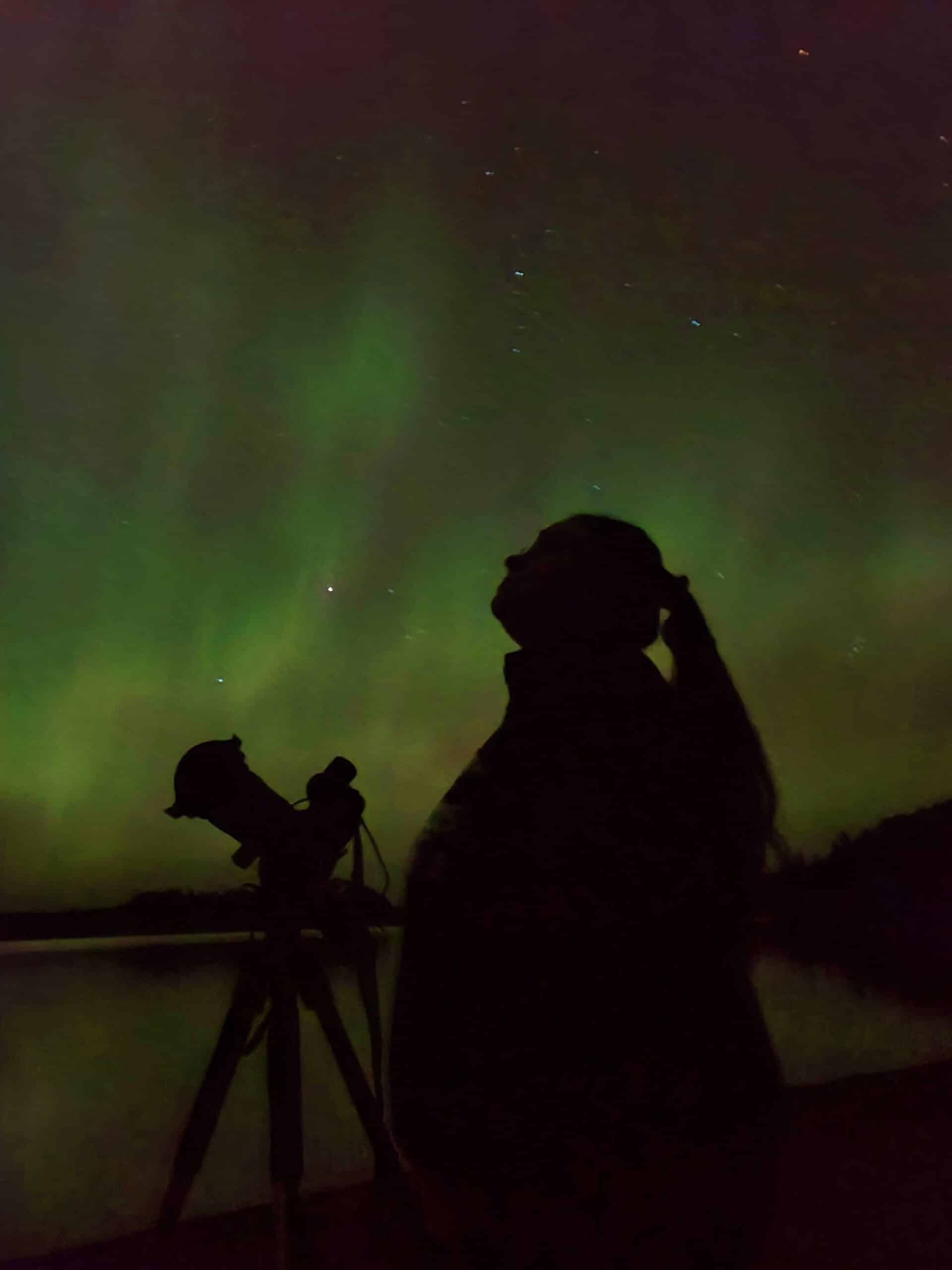
The Basics:
Campground Name: Quetico Provincial Park
Address: 108 Saturn Ave. Box 2430 Atikokan, ON P0T 1C0
Website: https://www.ontarioparks.com/park/quetico
Price: Ontario Provincial Parks uses a pricing matrix across all their parks. See 2024 Camping Fees for more details.
Reservations: Ontario Parks Reservations
Park Classification: Wilderness
Season: January 1, 2026 to December 31, 2026 for Backcountry Camping, Day Use, and Roofed Accommodation. Regular camping season is May 15, 2026 to October 13, 2026, though limited winter camping is available January 1, 2026 to March 31, 2026.
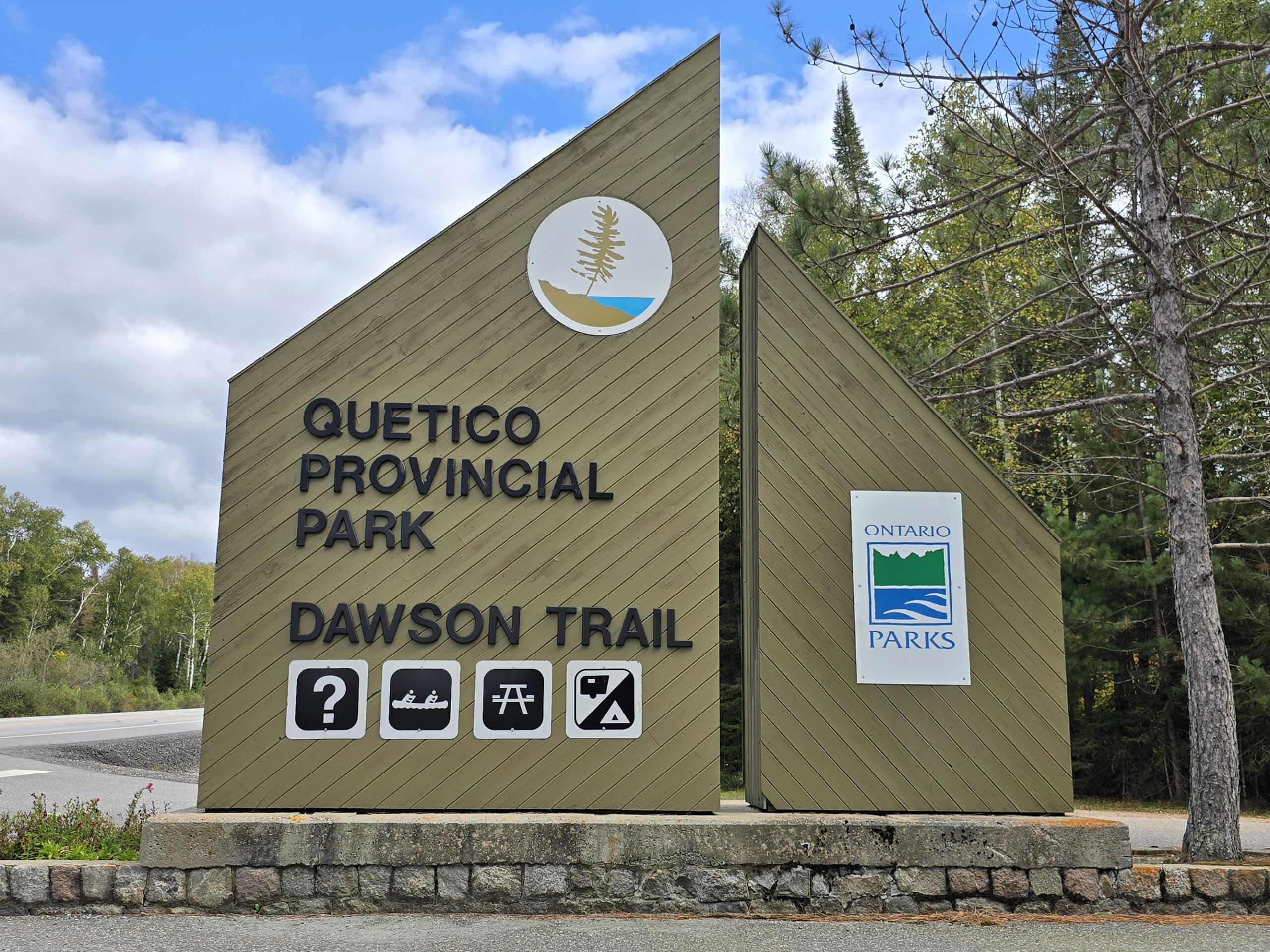
Logistics
Some basic information to help you plan your stay at Quetico Provincial Park:
Registration and Check In
As always, booking our campsites went quickly and easily through the Ontario Parks website reservation portal.
We booked fairly late in the season, so the pickings were kinda slim - that was on us, though.
Gotta even further plan ahead next time - I bet this is one of the parks where the best sites are snapped up the moment they’re available!
Signing in was also quick and easy, in the main office / Heritage Pavilion / visitor center; the staff were fast and friendly during both check ins.
The building was kind of elegant and felt like a museum, which was nice. Comforting.
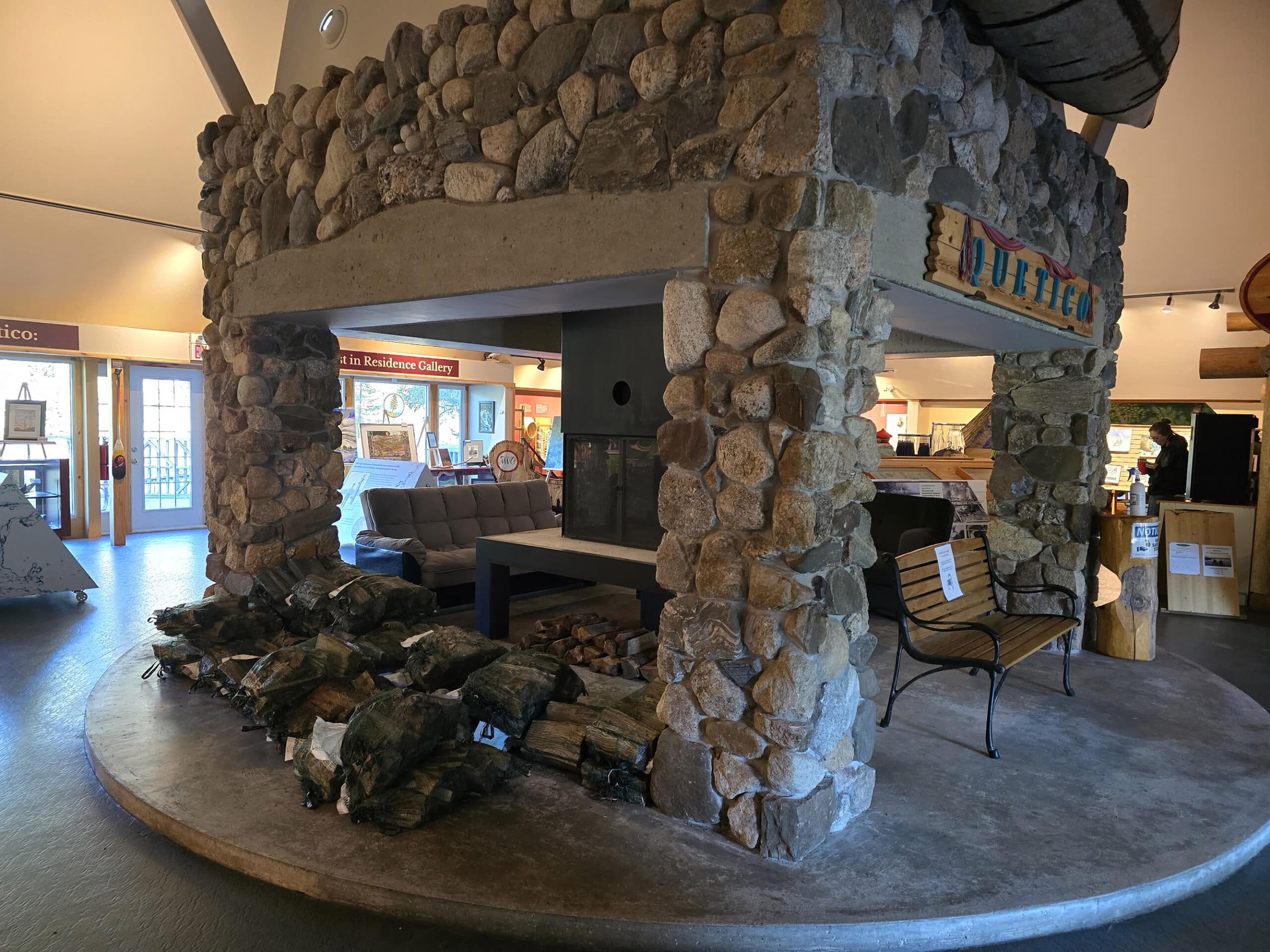
Maps and Signage
Signage throughout the campground was great - the bright blue and white signs for finding campsite sections all looked fairly new, or at least well maintained.
The campground map is decent, and they had a separate trail map available. In general, there was a LOT of information available for whatever you want to do.
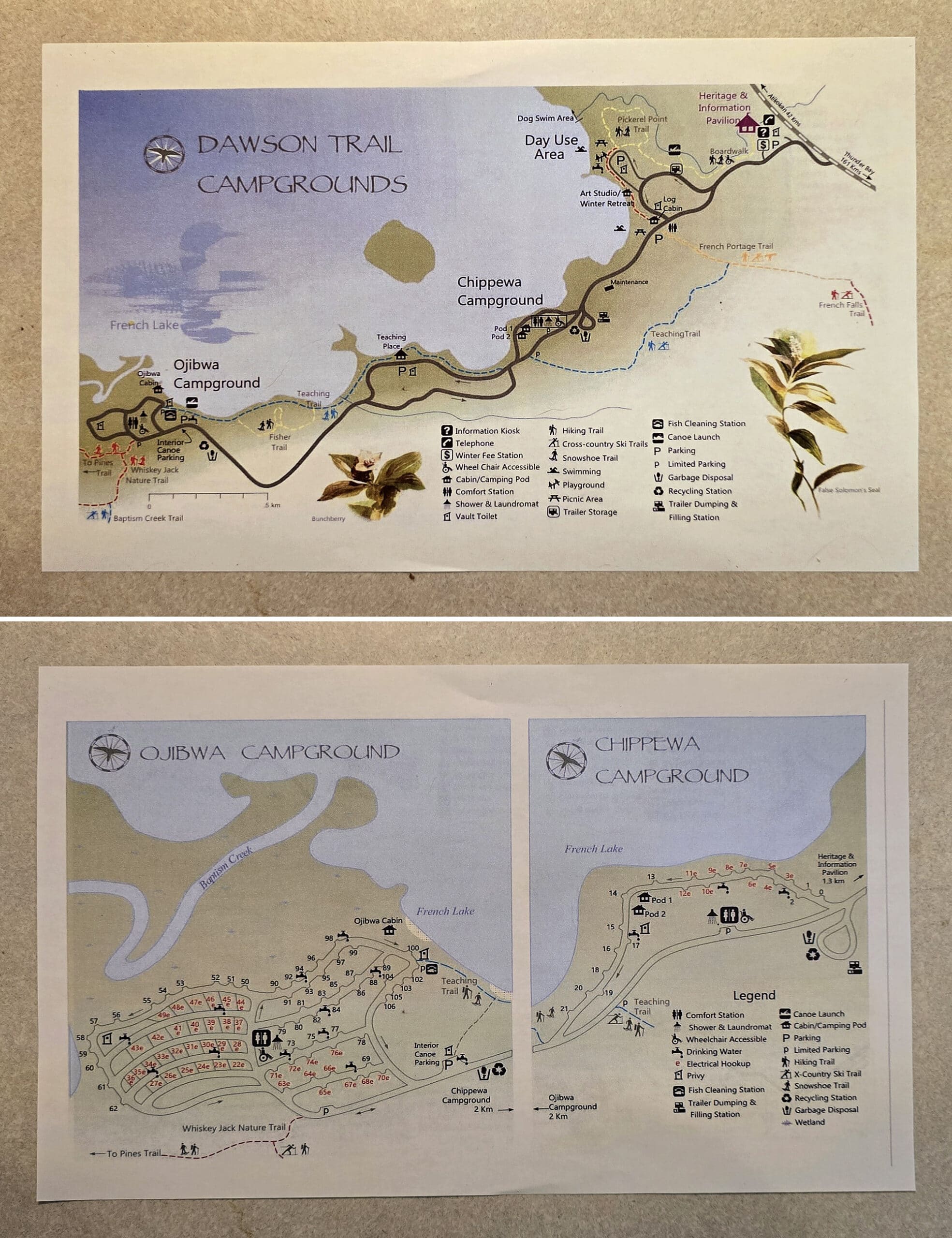
Other areas leave a bit to be desired, with small / low contrast / poorly placed / non-existent signage. Overall, it’s a small enough campground that you shouldn’t have a hard time getting around, if you’ve got the map on you.
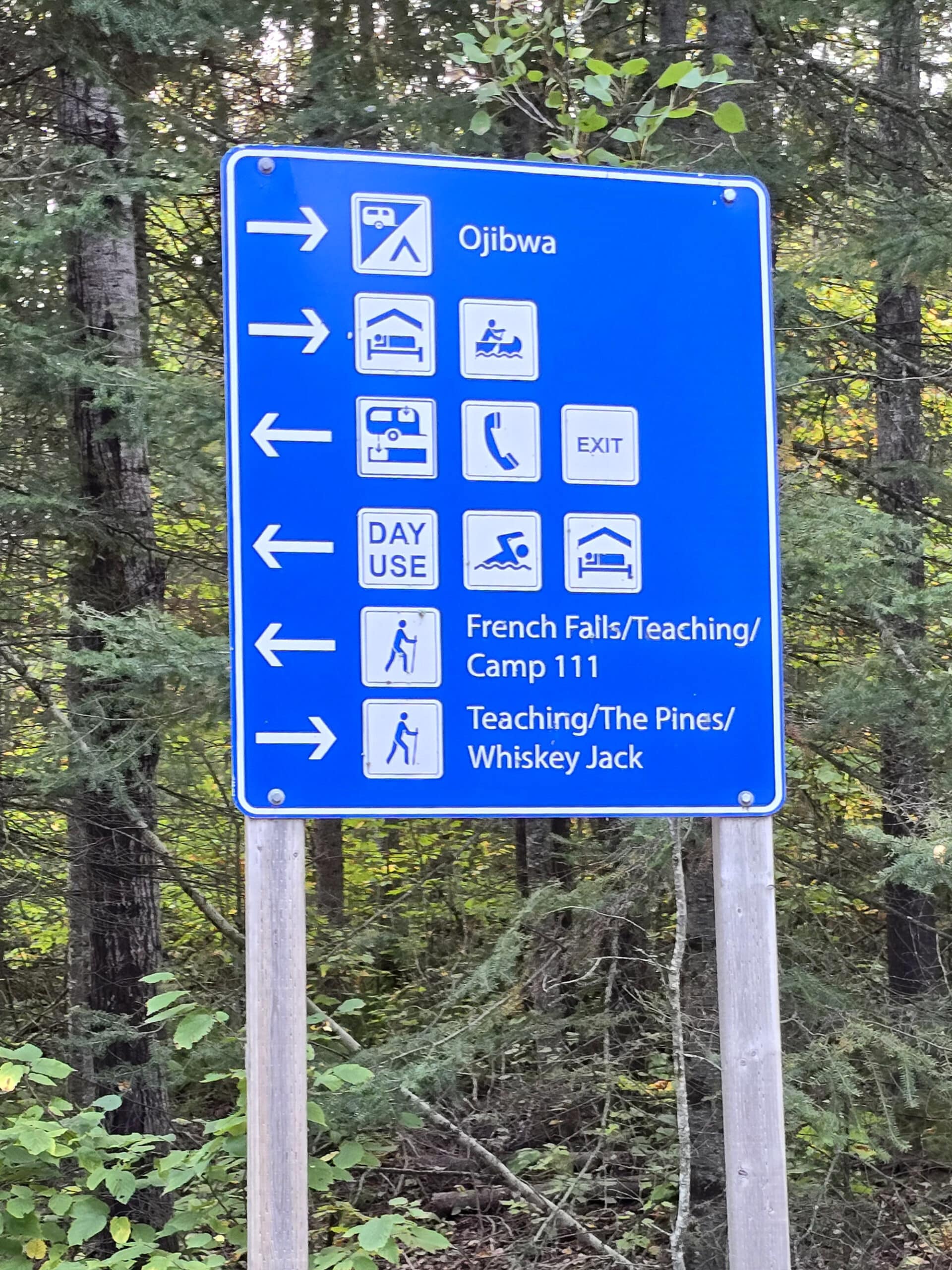
Waste & Water Services
As with most Ontario Provincial Parks, the camp sites are a mix of electric and non-electric sites, and none of them have sewer or water hookups.
There is a “Poop Loop” - the trailer dumping station - towards the front of the camp ground.
As far as potable water goes, there is a fill platform next to the dump station, as well as water taps throughout the campground loops.

There was also a decent sized garbage / recycling center available.
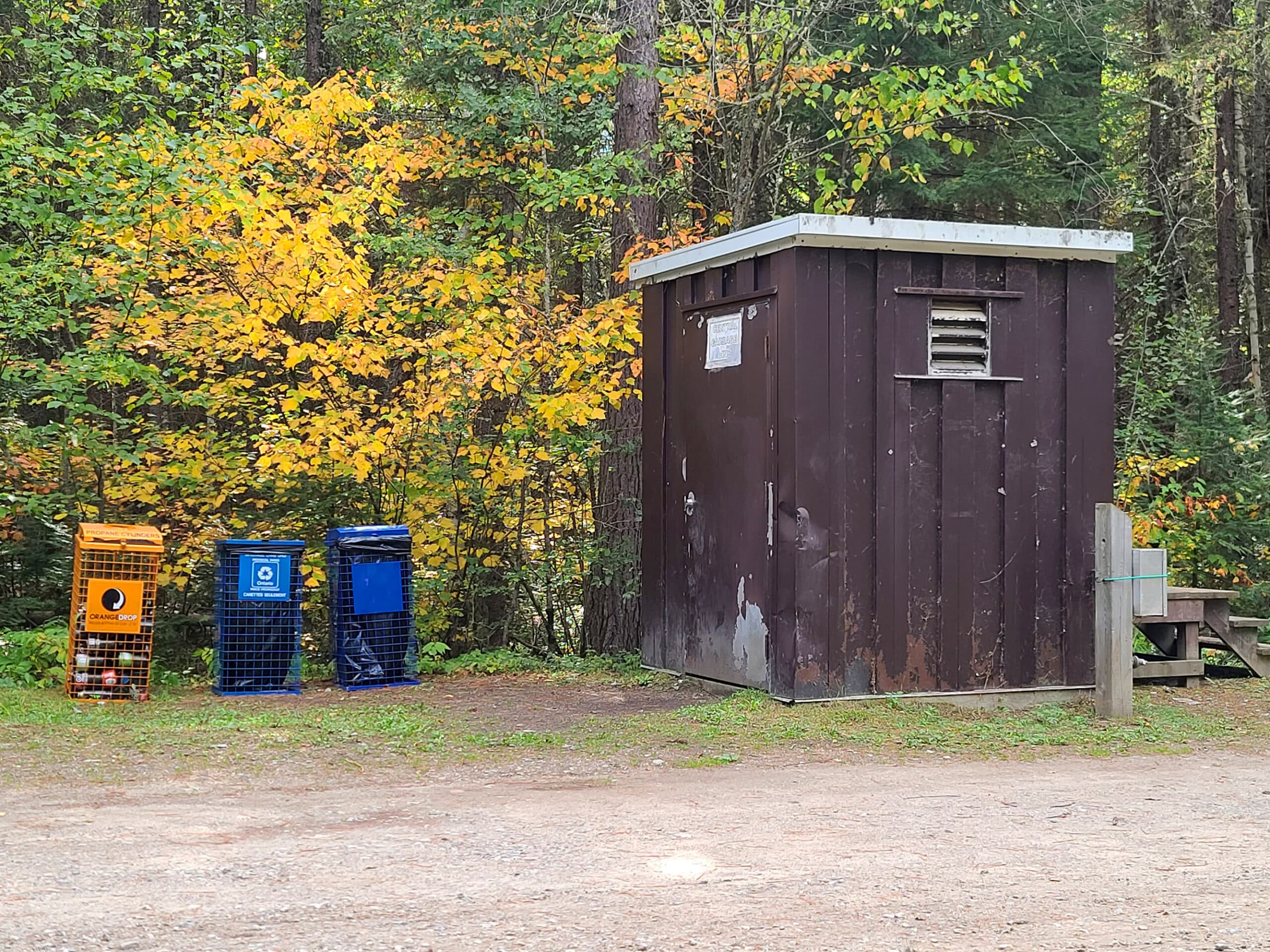
Connectivity
On our first stay, cell reception (Rogers) was a bit spotty, but enough to get by with the basics.
On our second stay, our connectivity was FANTASTIC - seriously some of the best reception we’ve had during the whole trip - throughout most of the campground area.
We did notice a cell tower across the lake, and don’t remember seeing that last time... so that could be the reason for the marked improvement in connectivity.
Anyway, there was no wifi at the park.

Accessibility
Quetico is a shockingly accessible campground, given how far out it is, and how much of the park is focused on very “able” activities.
The boardwalk from the office is 0.8 km each way, and is ACTUALLY accessible. Not only is it boardwalk the whole way, it’s flat and even, with a kind of wire overlay for traction.

There’s also an accessible beach, with a boardwalk across to the beach (there’s a parking lot across the main road from it), and a Mobi-Mat over the sand.

... also, they offer free loans of an all-terrain, beach wheelchair!
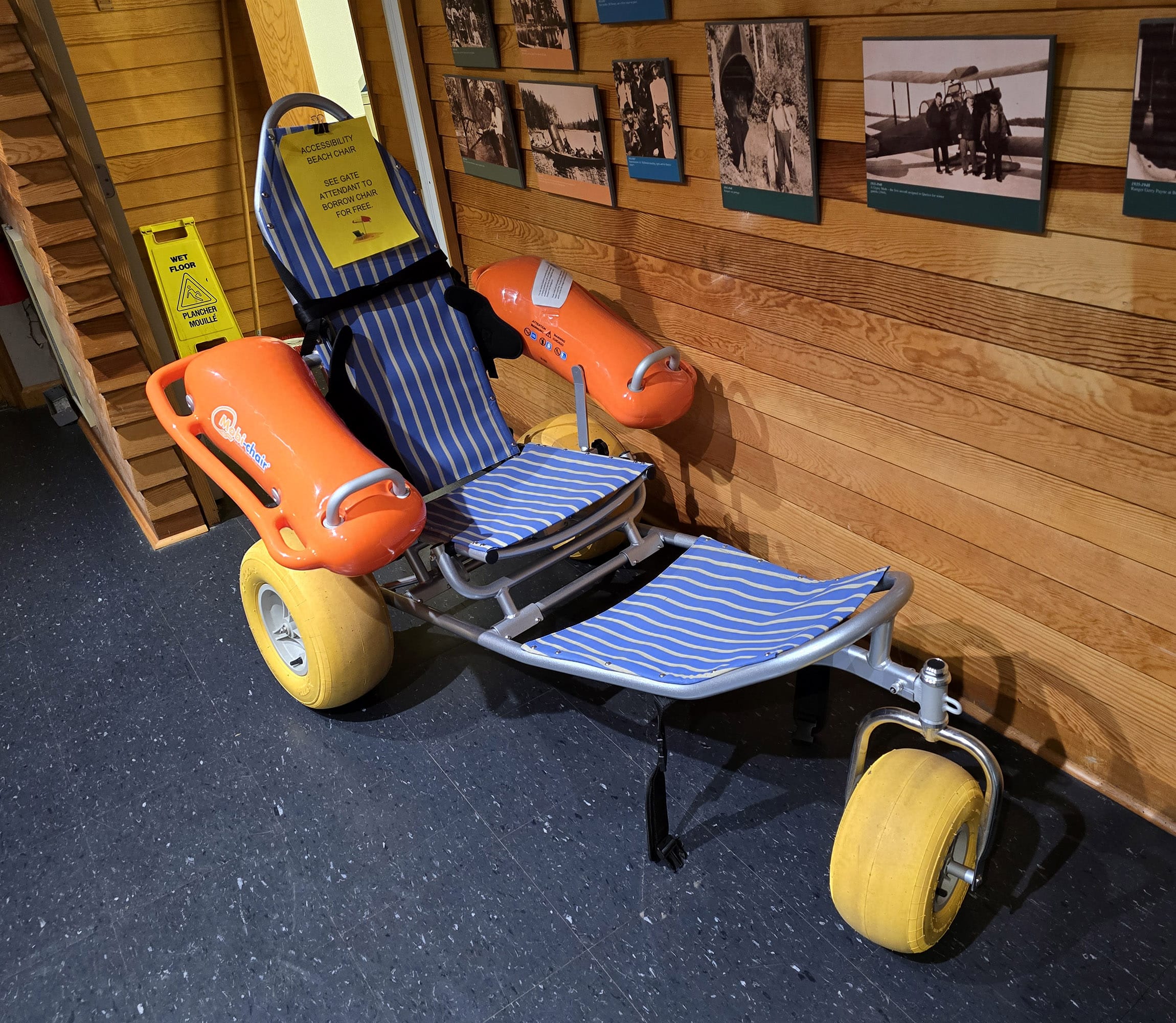
The Visitor Centre is *mostly* wheelchair accessible, though the stairs down to the library are not.
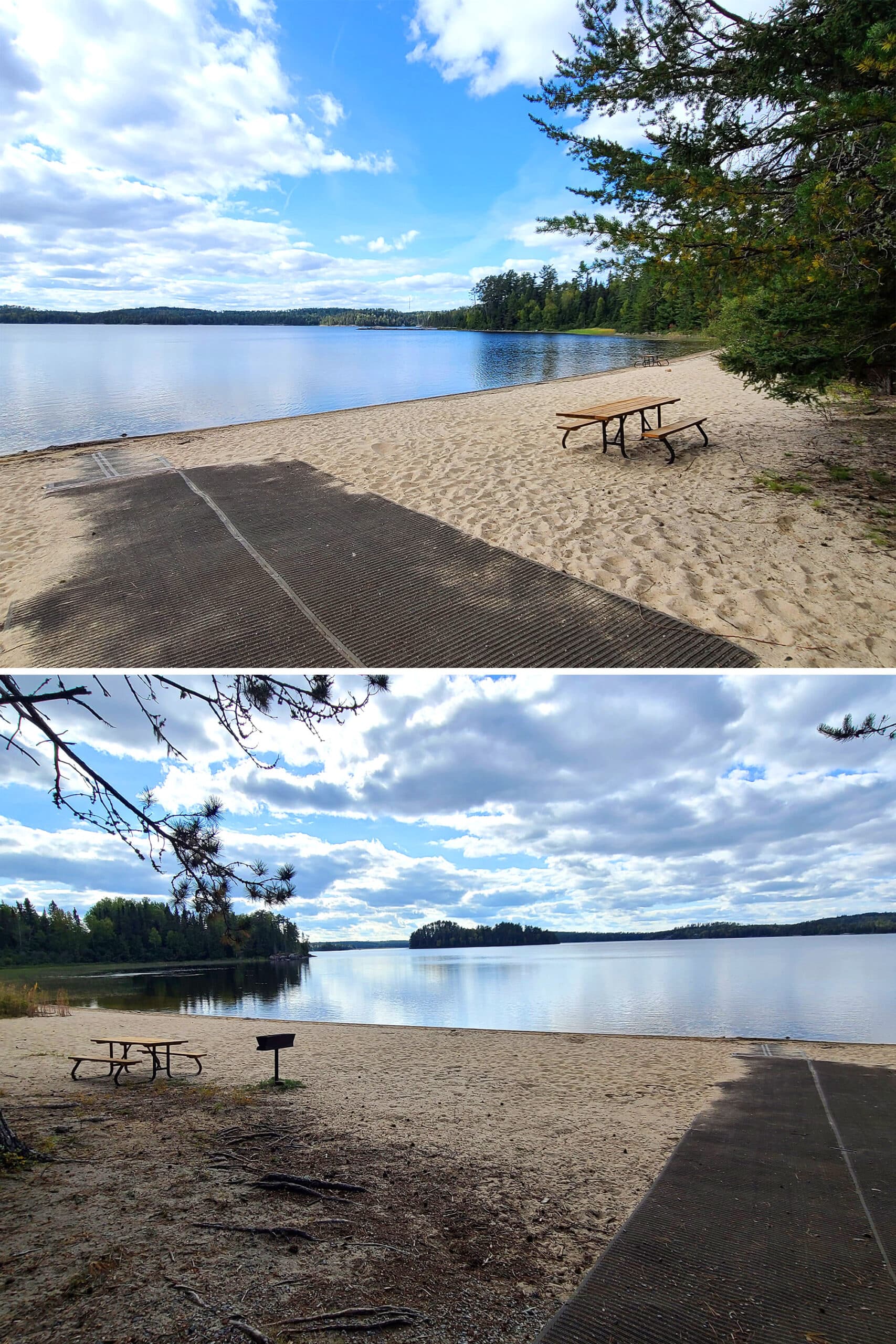
Pets
Pets must be leashed at all times in the park, aside from at the off-leash pet beach. This secluded beach is a little further away from the parking lot, than the main day use beach.
There’s also a pet friendly trail, leading up to that dog beach - the Pickerel Point Trail (see the hiking section, below, for more details!).
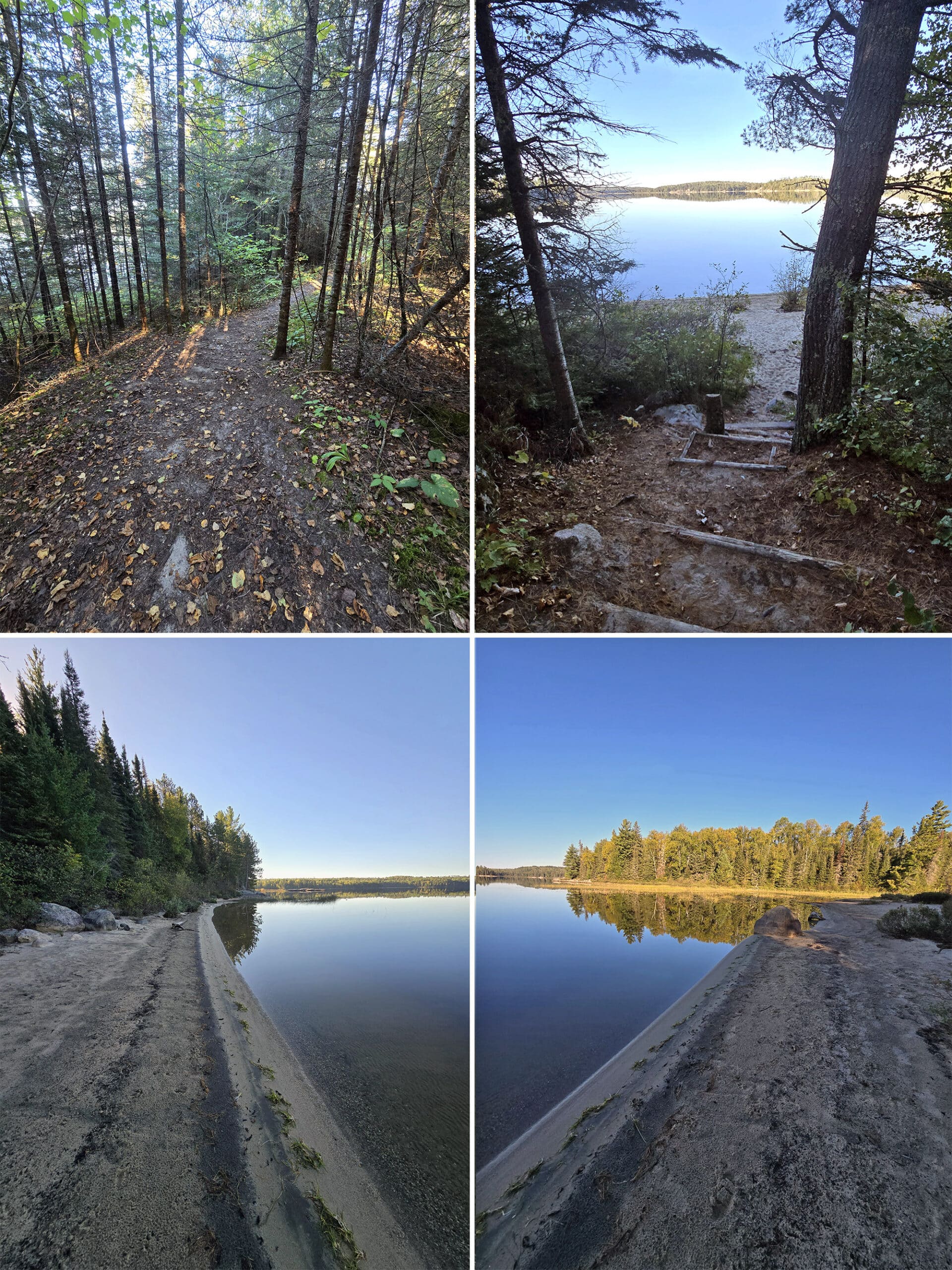
/
Parking
All of the camp sites we saw *definitely* seemed to be big enough to accommodate an extra vehicle or two, beyond your camping equipment.
Aside from that, there’s plenty of parking at the Heritage Pavilion, day use area, canoe parking lot, etc. The parking is kind of limited near both of the comfort stations.

Legal Issues
Because we’re both Canadian citizens and were traveling by land - through Canada - we didn’t have to worry about dealing with the Canada Border Services Agency, getting a remote area border crossing permit, application forms, or anything else that U.S. citizens coming from across the southern border have to deal with.
For those crossing the international border into the park, you’re expected to work that all of that out prior to arrival, as applicable.
There’s a seasonal customs outpost 47 km from the Lac La Croix ranger station, but other ranger stations don’t provide customs services, and require pre-clearance to Canada.
Other things to keep in mind:
Quetico is home to multiple archeological sites and areas of historical interest. Removal or damage of any artifact, natural object, relic, or site of archeological/historical interest is forbidden.
This includes - but is not limited to - the Anishinabe pictographs, arrowheads, bones, etc.
With regards to the pictographs, they’re sacred to the Anishinabe people, so you’re expected to approach them respectfully and quietly.
Don’t touch them in any way, as contact with oils, sweat, etc can cause the natural pigments to degrade even faster than time alone.
Finally, the possession and use of firearms is banned in the park. The definition of “firearm” is incredibly broad here: air guns, bow / cross bows, hand guns, paintball guns, pellet guns, rifles, shotguns, and even slingshots are prohibited.
Hunting - or even harassing - wildlife is also prohibited in Quetico Provincial park.
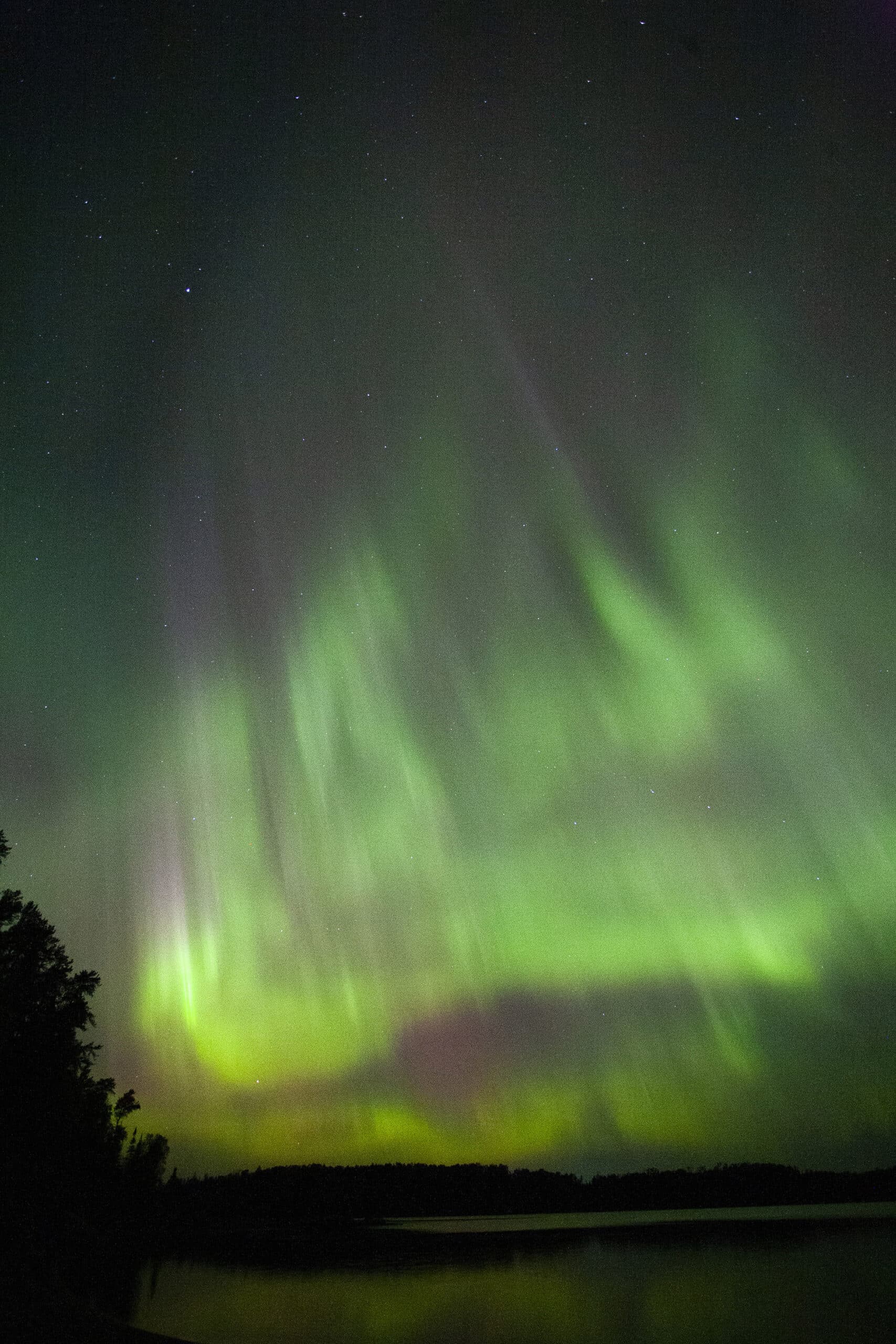
Campground Amenities & Info
Overall, this park is really well appointed, and they obviously applied a considerate eye to the people who would stay there, and the activities they would be doing.
Here’s some more specific information on the amenities offered at Quetico Provincial Park:
Creature Comforts
Each campground loop had a comfort station, with flush toilets, laundry facilities, and showers. We liked that the laundry was the closet type, rather than the room type.
There are also flush toilets located at the day trail parking lot, day use area, and in the Heritage Pavilion, as well as vault toilets throughout the park.
The campground also makes using the facilities easy for those visiting by canoe - there are canoe racks EVERYWHERE!

Park Store
The camp store was located in the front office / heritage building with registration.
It was well appointed, selling all of the usual provincial parks fare - t shirts, souvenirs, firewood, etc.
There are also small camp stores located at each entry station, and at the Park Office in Atikokan.
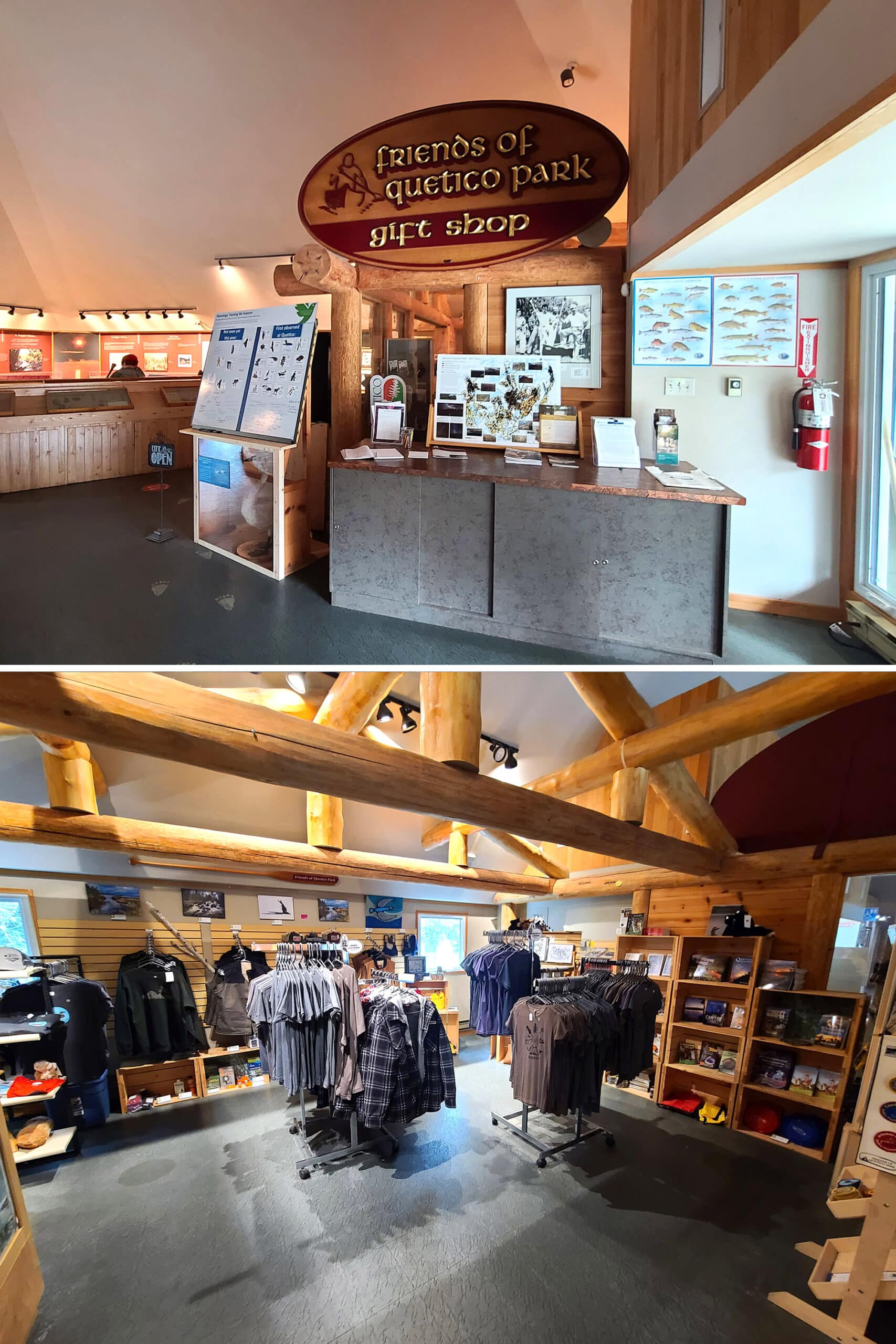
Visitor Centre
The Dawson Trail Heritage Pavilion is the relatively large building you encounter soon after entering the park by road, and is where you register for your camp site.
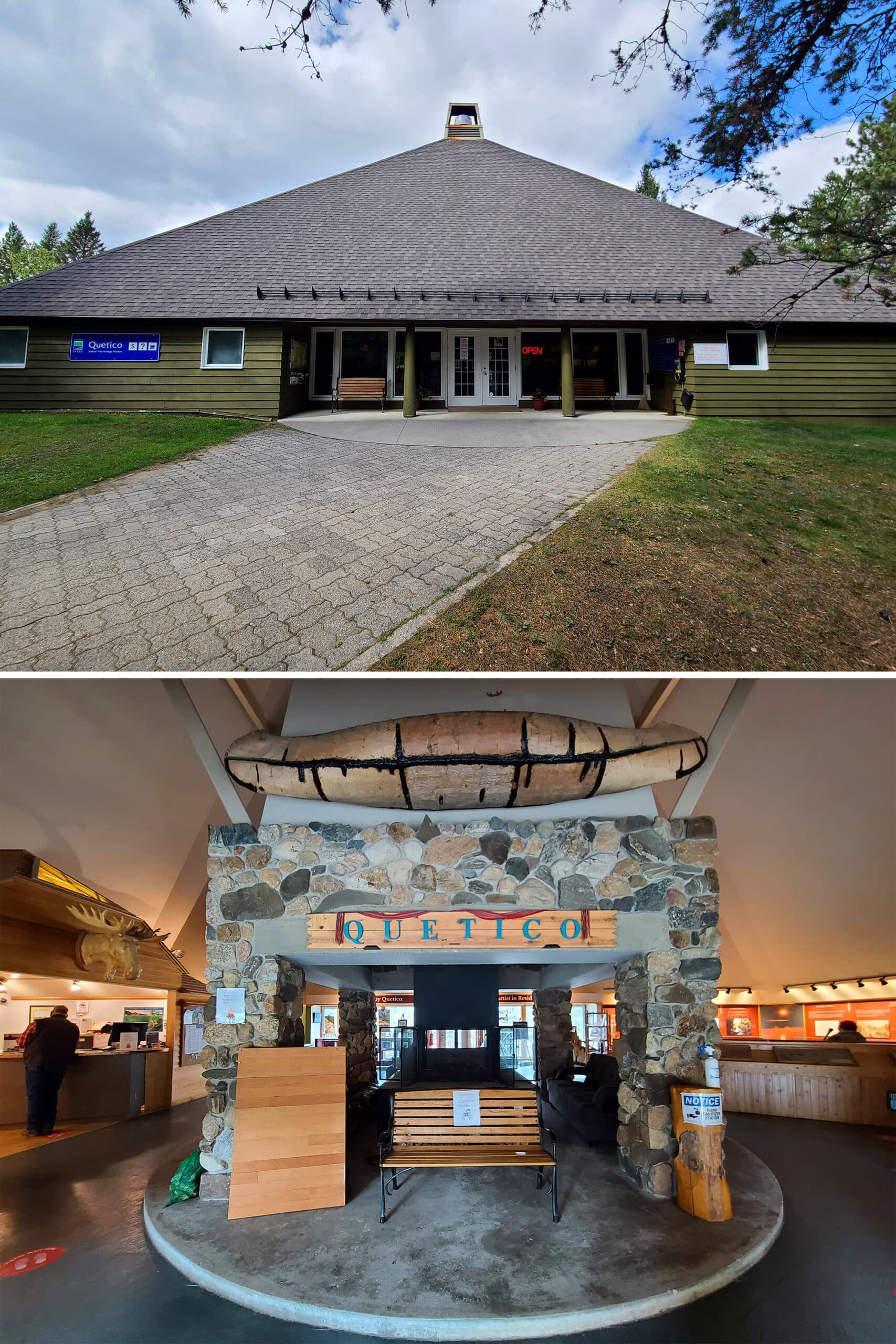
It also serves as the visitor center, with exhibits and displays on the history of Quetico - which has been a provincial park for over 100 years.
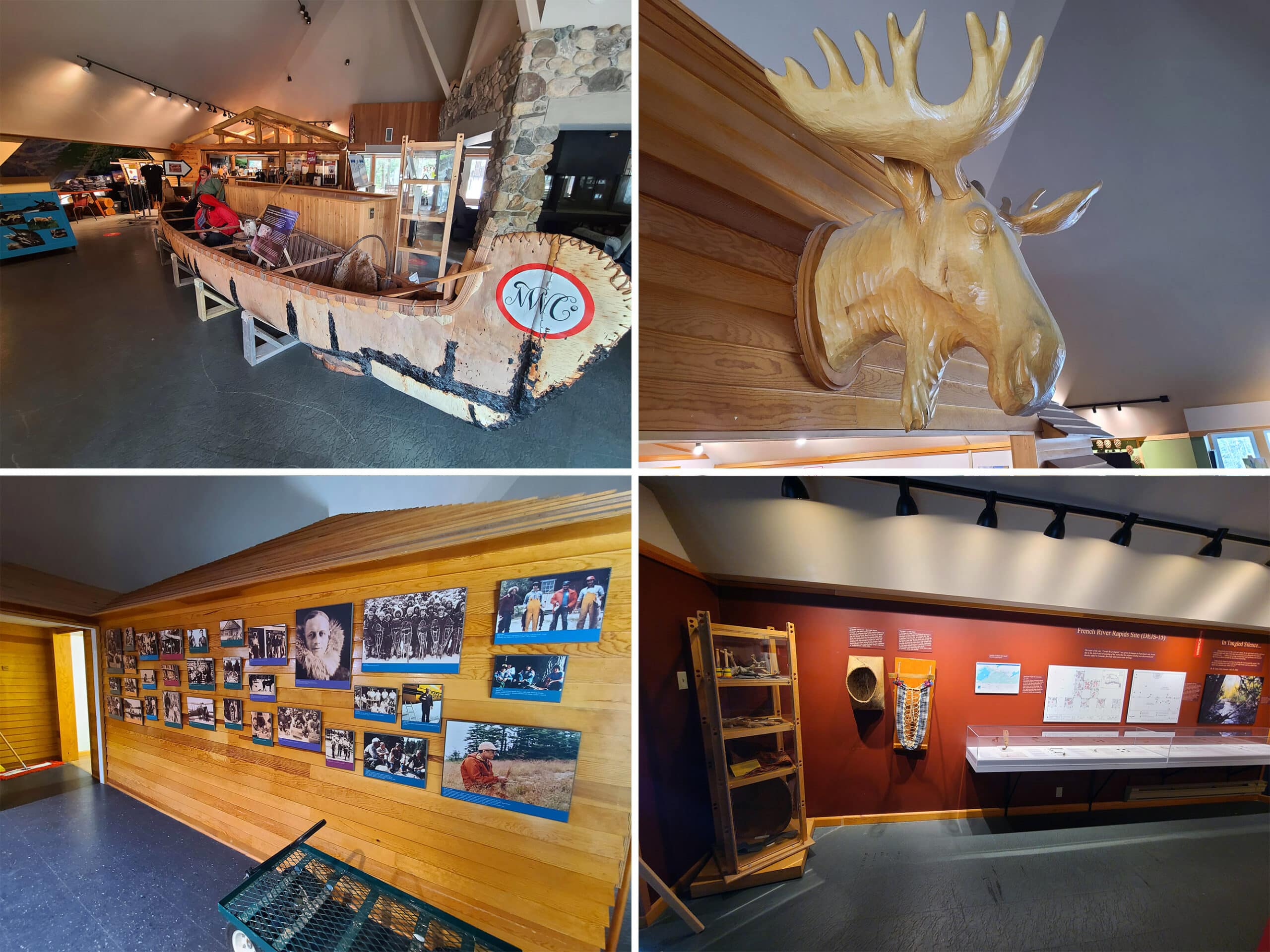
To aid in that education, the library has a good collection of resources - articles, books, maps, photographs, and even oral history recordings.
We had the opportunity to go check out the library on our second visit to Quetico.
Due to the situation since early 2020, it’s been a looong time since we’d been in a library, and we both got pretty misty eyed over it.
Then, I saw that they had a LOT of information on my family. Like... a lot.
I actually got to see a photograph of my great grandmother, dated within my lifetime! I don’t even know if I met her.
It was a wild experience reading about people that my great-aunt has told me about.
Beyond that, we loved the fact that it was available, comprehensive, and actually had a librarian on staff... rather than being a random pile of books in a corner.
It’s also just really comfortable and cozy - there’s a kids table, a couch, and a little table and chairs study setup.
It’s definitely a research library, so it’s very much focused on park related things, as well as on the history of the Lac La Croix community.
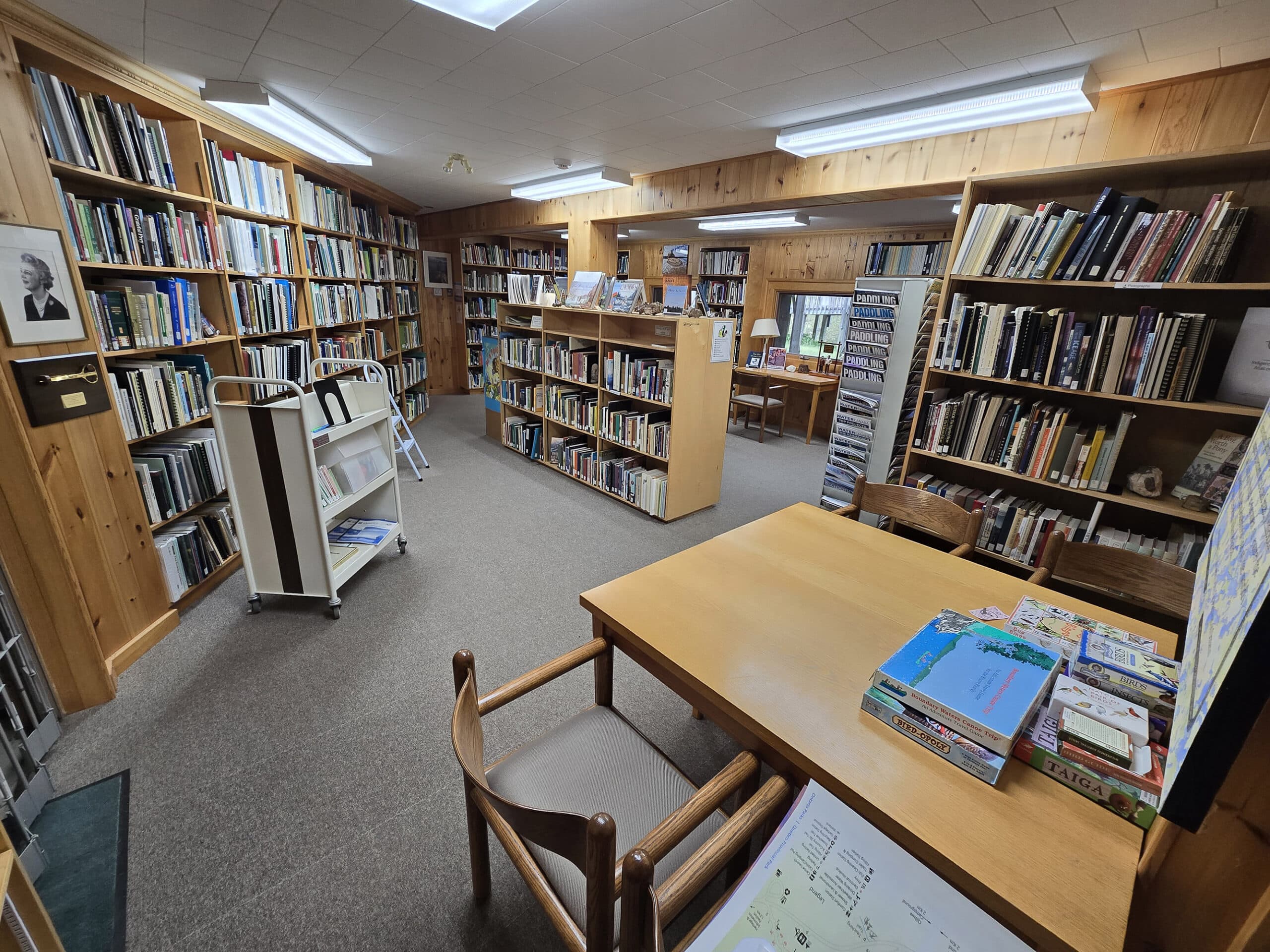
Day Use Area
The campground has a fairly large day-use area on the edge of French Lake, with a beach, playground, and picnic facilities - including grills.

It was quiet during each of our stays, peaceful!
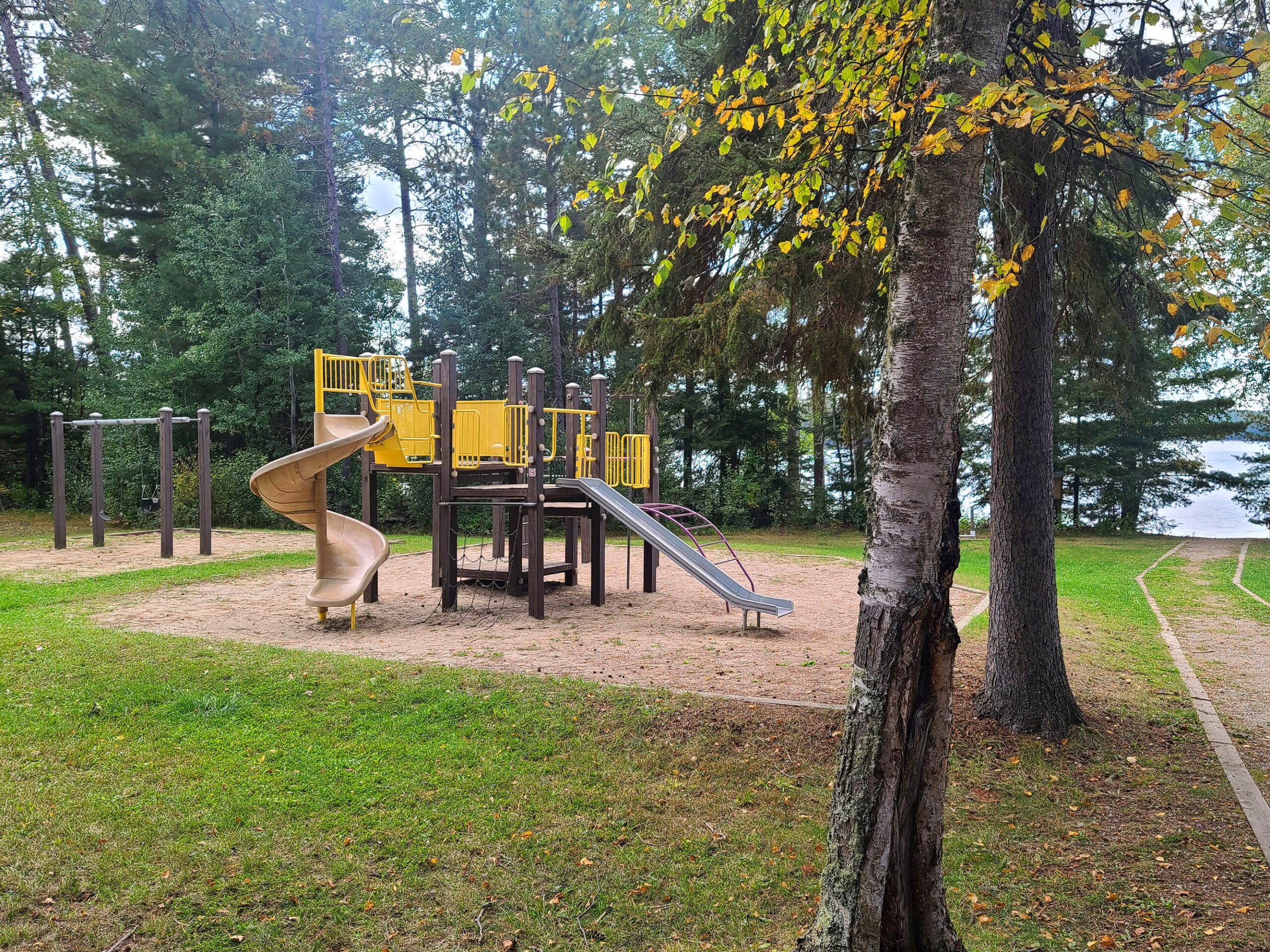
They were really cool - we think these may have been added since our first stay, as we certainly didn’t remember seeing them.
Absolutely gorgeous work!
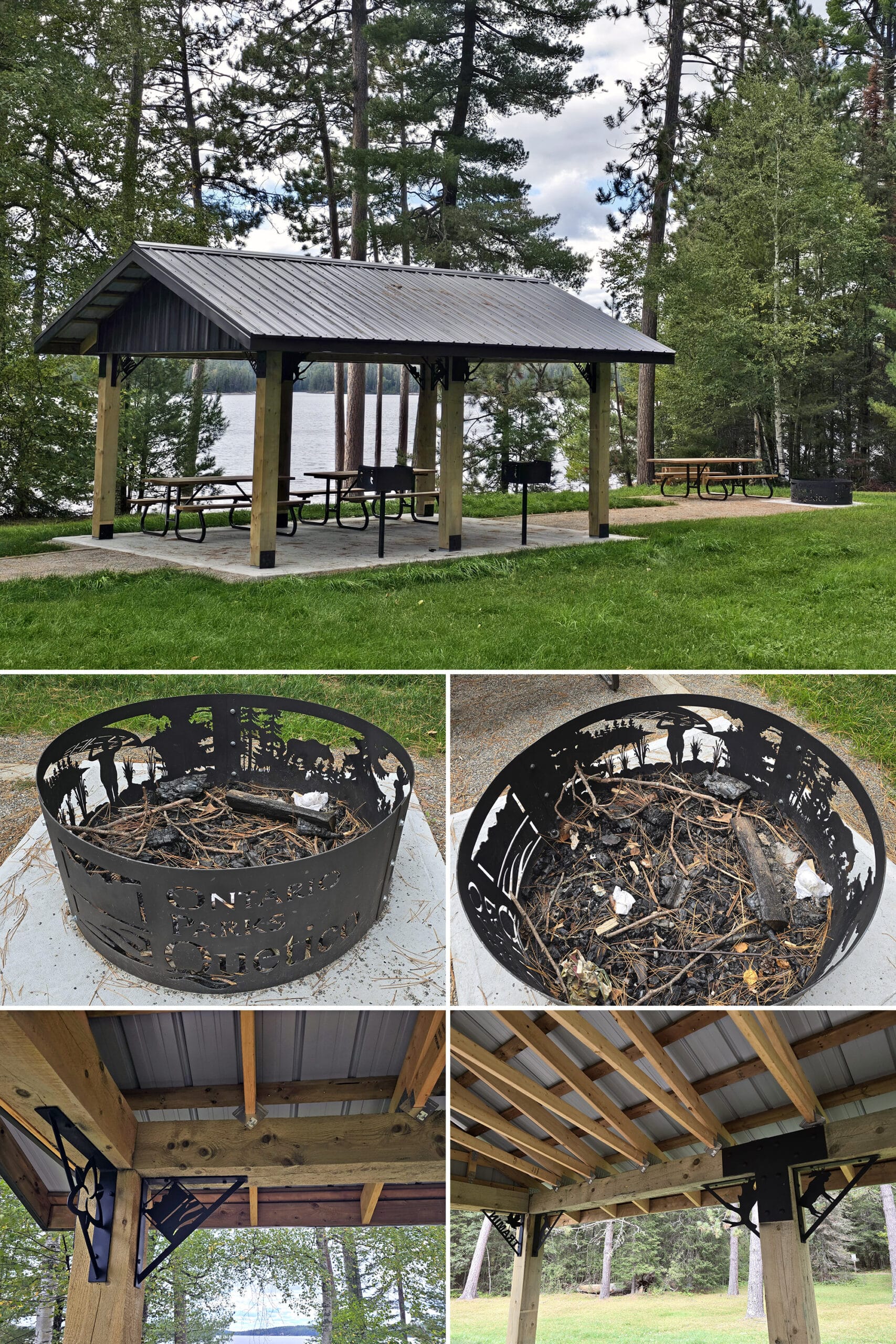
Campsite Details
The Dawson Trail Campground has over 100 camp sites, divided into two loops - Chippewa and Ojibwa.
These camp sites have a mix of electrical and non-electrical hookups / lack thereof.
All the sites seemed pretty big, and we saw a range of trailers, motorhomes, and pop up campers. Some sites are pull through - especially in Ojibwa - most of the ones in Chippewa look to be back-in.
A lot of the outer edge sites in Chippewa have a bordered platform to park on, ours was impressively level.
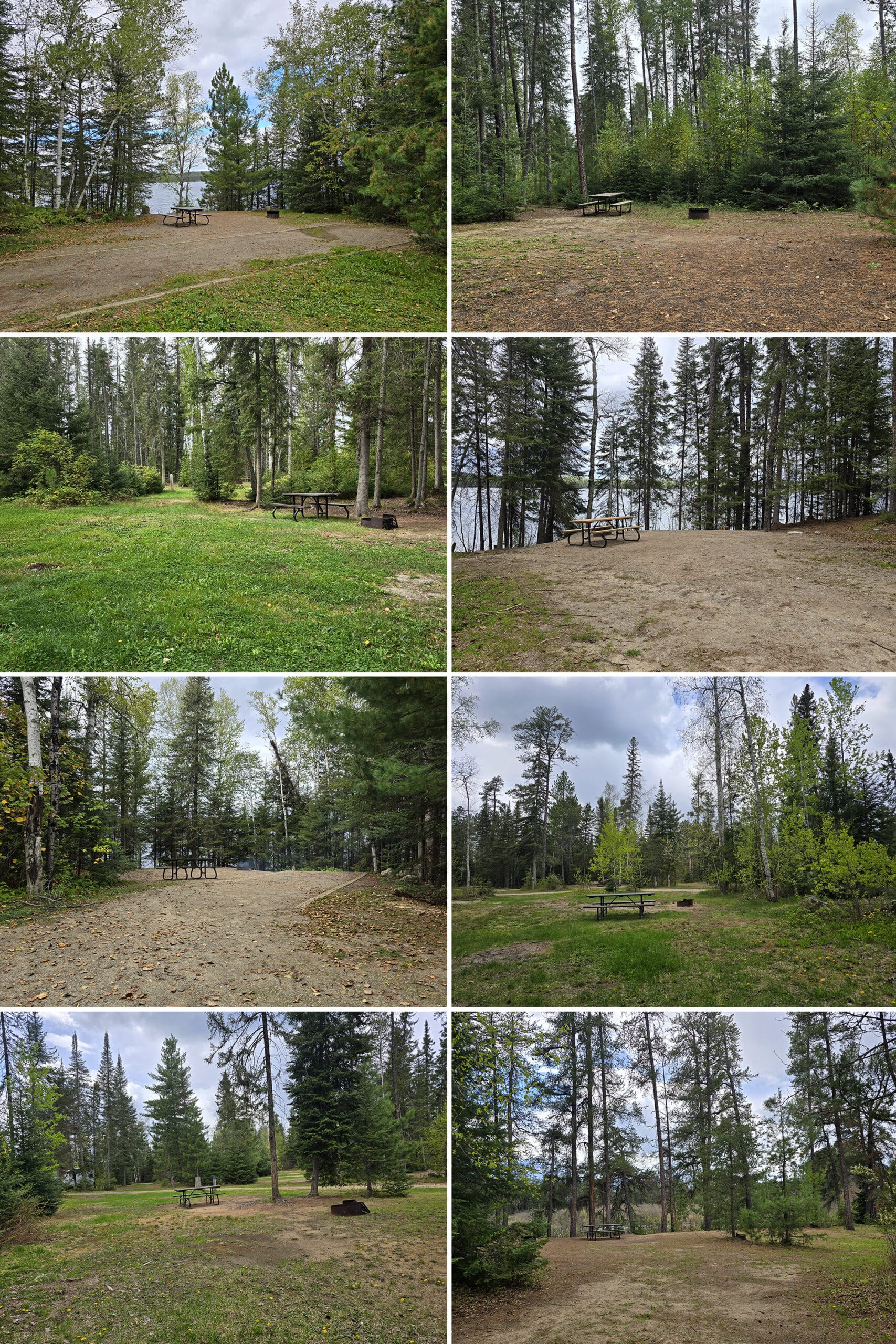
Our Campsites
We stayed in 2 different sites during our stay, on account of availability at the time of booking.
The first night was in the Ojibwa loop, a pretty basic - but spacious - pull through site.
Our second night was #9 in Chippewa - had a great water view, mostly north facing, but it was too steep to really get DOWN to the water. Really nice anyway, though.
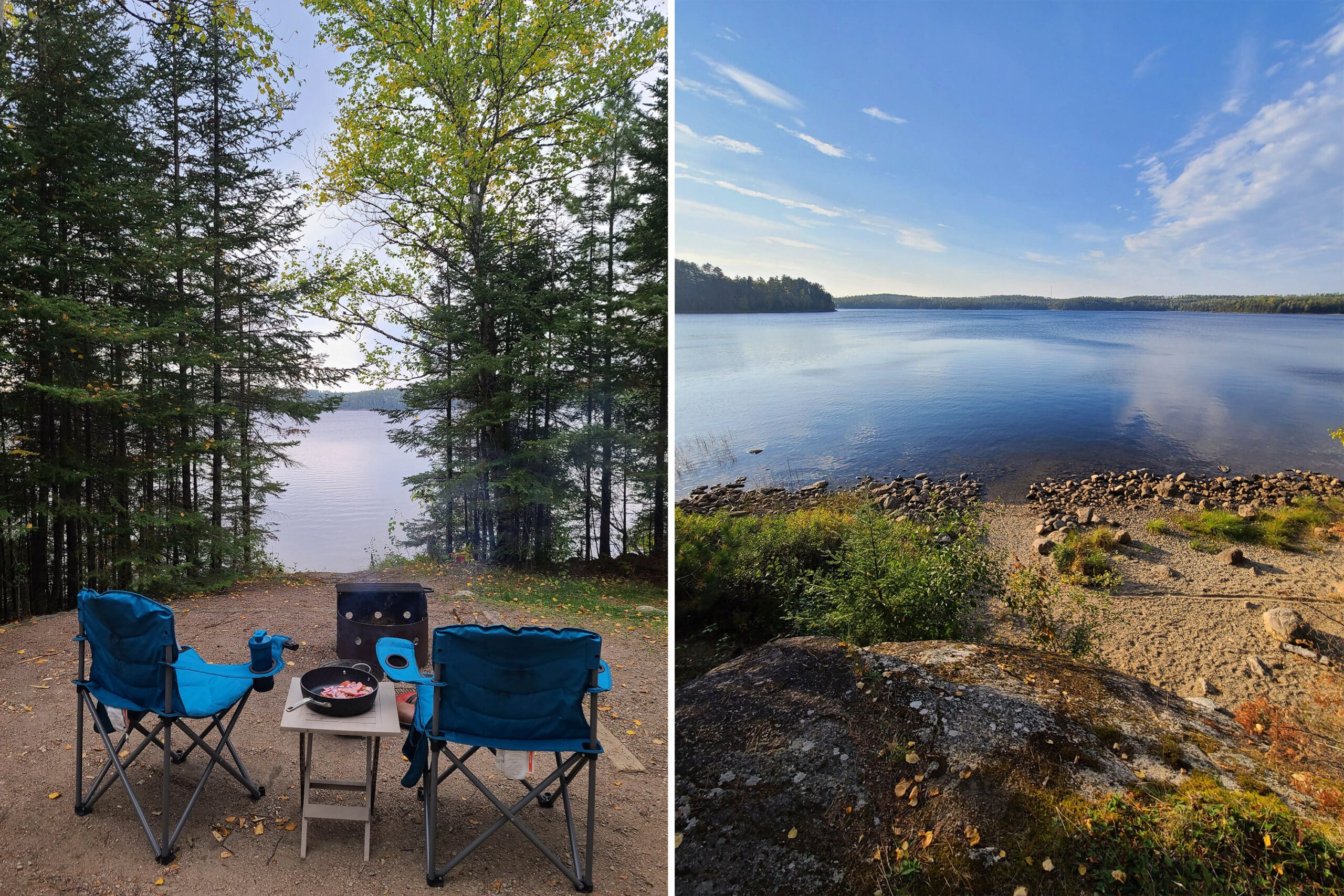
Roofed Accommodations
Quetico has two different options for roofed accommodation in the Dawson Trail Campground, and both seem to be available year-round.
Camping Pods
The camping pods - two of them - seem to be a newish option, as neither one of us recall seeing them during our 2023 visit. To be fair, we were staying in the other campground.
Anyway, these cute little pods are in the Chippewa campground loop.
They don’t have running water or washroom facilities, but they’re next to an outhouse, and pretty close to the comfort station. (Which is only open during the regular camping season).
Each sleeps 4, and has electrical power and baseboard heating, as well as a firepit and BBQ grill outside.
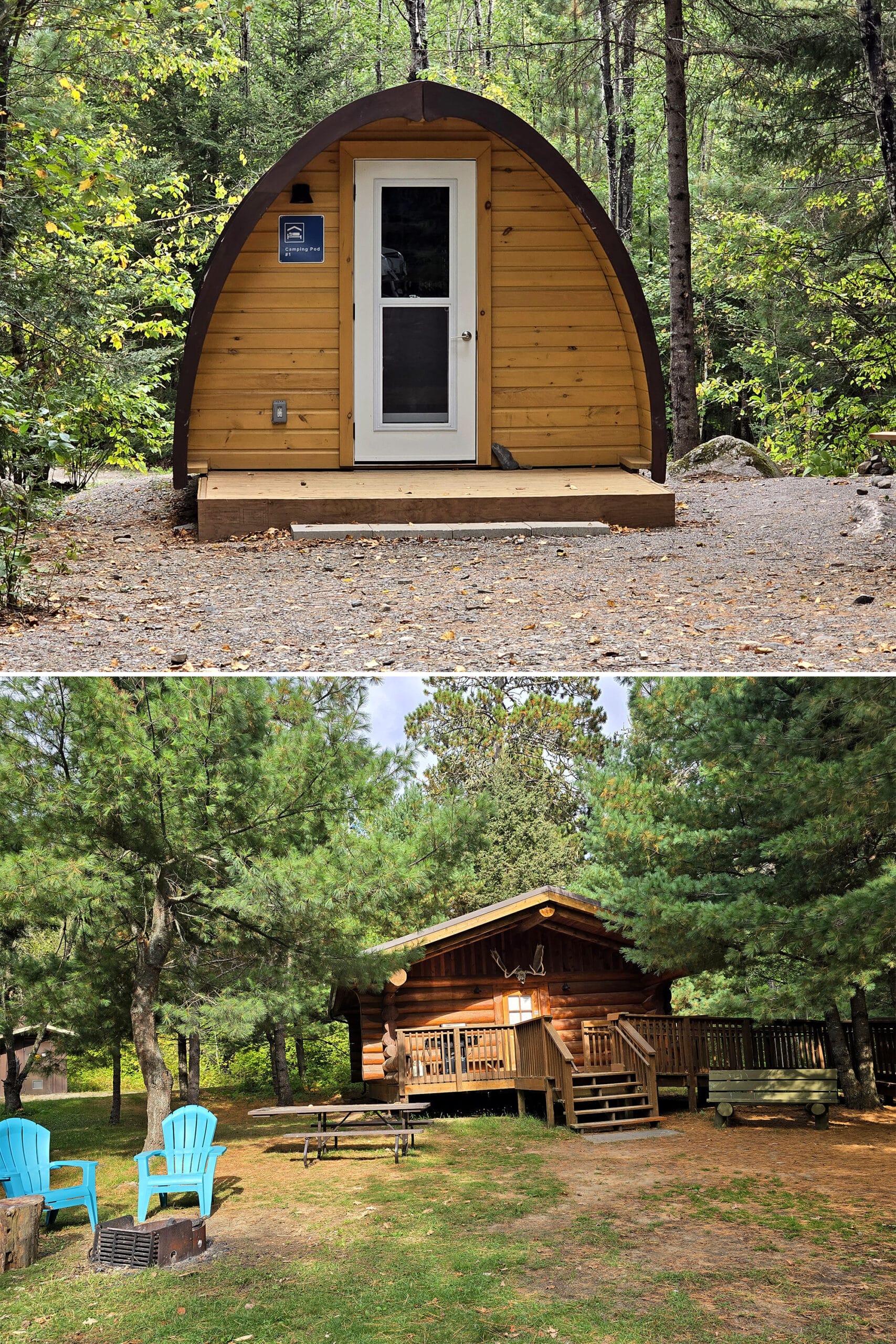
Rustic Cabins
Quetico has 3 cabins for rent - 2 in the Chippewa Loop, and 1 on the beach in the Ojibwa Loop.
None of them have running water or washrooms, so you’ll have to use nearby outhouses. Also to note: The comfort stations - with showers - are apparently open in the summer camping months only.
Most of them have interesting logistics beyond that.
In the winter, the Ojibwa cabin can only be accessed by skiing or snowshoeing in.
We couldn’t even see the Art Studio Winter Retreat, it seemed pretty well hidden by trees and brush. According to their site, it’s walk-in access only.

Back Country Camping
While it’s totally not our thing, Quetico does offer some back country camping in the park.
Check out their website for more details and restrictions for booking and using the backcountry campsites.

Share the Love!If you’ve made one of our recipes, be sure to take some pics of your handiwork! If you post it to Bluesky, be sure to tag us - @2NerdsInATruck, or you can tag us on TikTok, if you’re posting video. We're also on Pinterest, so you can save all your favourite recipes and park reviews to your own boards! Also, be sure to subscribe to our free email newsletter, so you never miss out on any of our nonsense. Well, the published nonsense, anyway! |
Entertainment and Activity
As one of the largest provincial parks, it should be no surprise that there is a LOT to do at Quetico. Here are some of the main attractions:
Dark Sky Viewing
Quetico is an international dark sky park - and it gets VERY dark there, obviously. The stars are clearly visible, even right above the campground areas.
We were lucky enough to have the Aurora Borealis make a STUNNING appearance on our first night at Quetico. First time I ever saw northern lights!
It was also visible right above our camp site, though it was much brighter - and with a better viewing area - when we went to the beach.
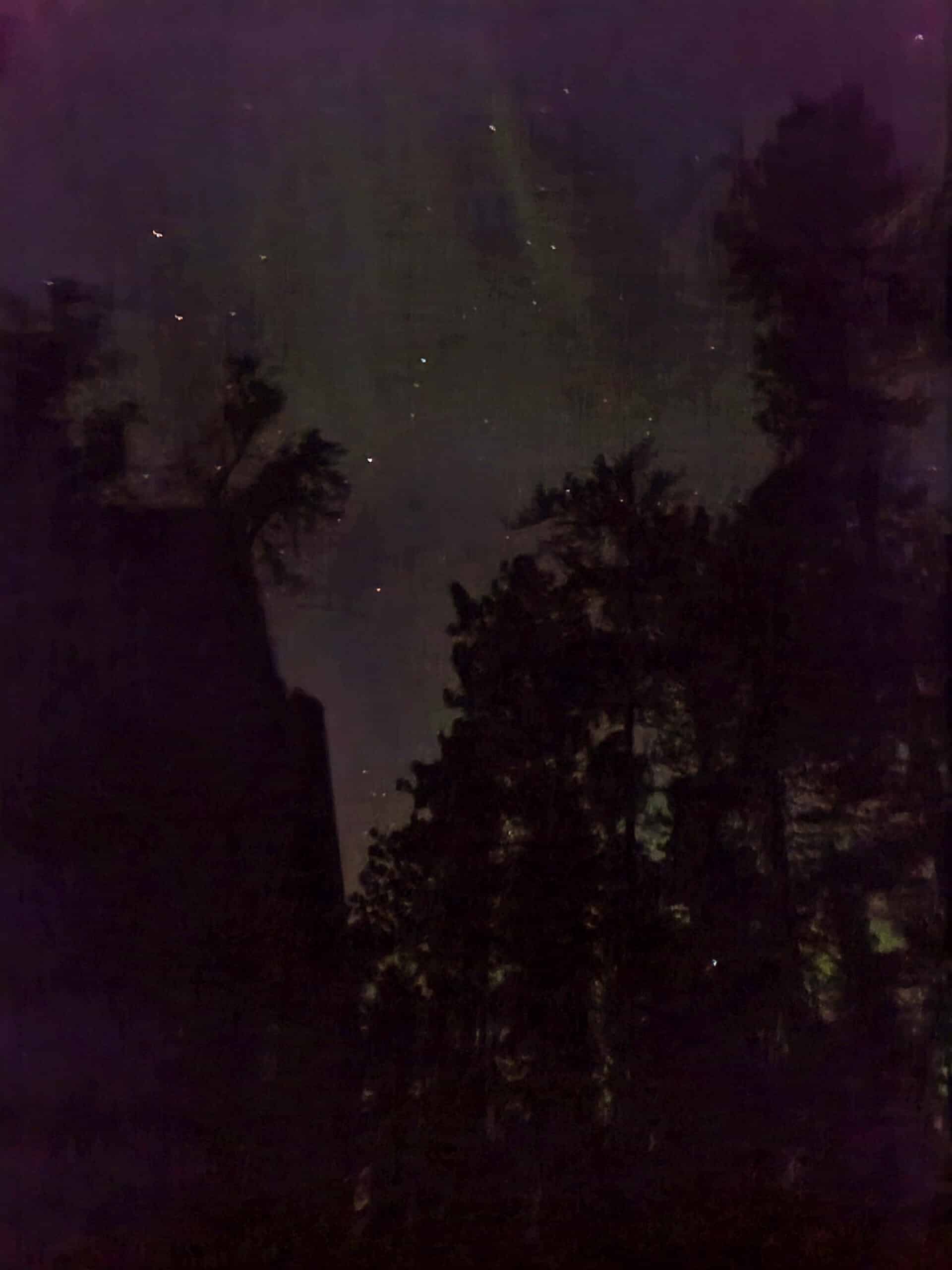
The lights danced across the whole sky, we did not have a wide enough angle lens to capture it all. There was a single flashing light across the lake, but it didn’t really ruin anything.
Aside from that light, no light pollution at all. The aurora was so bright that it lit the beach as bright as a full moon would have!
We were far enough north that the aurora was both in front of us to the north, and directly overhead at times.
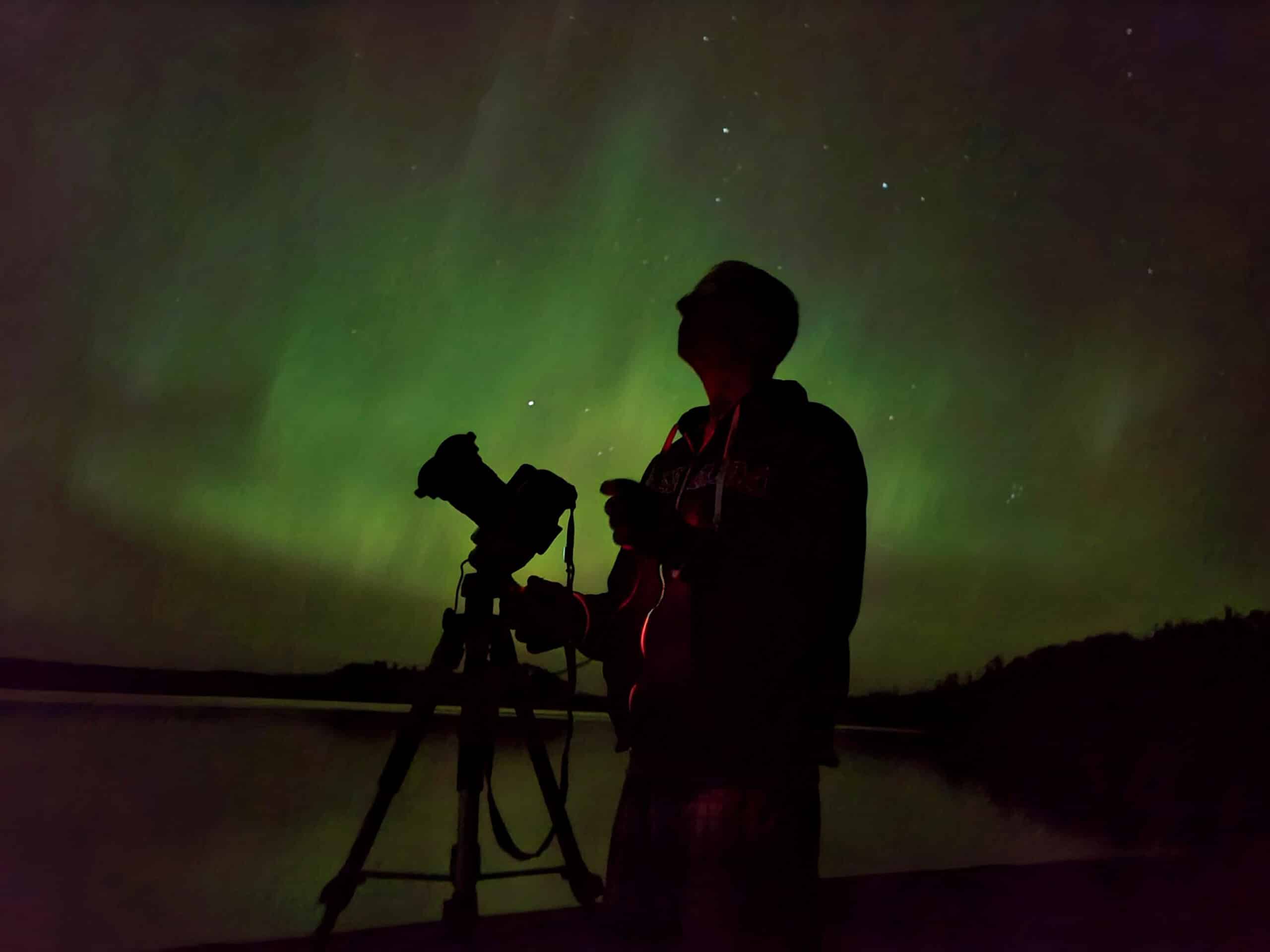
It was amazing, I have never seen anything like it. The loons calling out in the distance added some ambiance - it was surreal.
In 2024 on our second visit, we had multiple northern lights shows, with one even being better than the one our first time at Quetico!
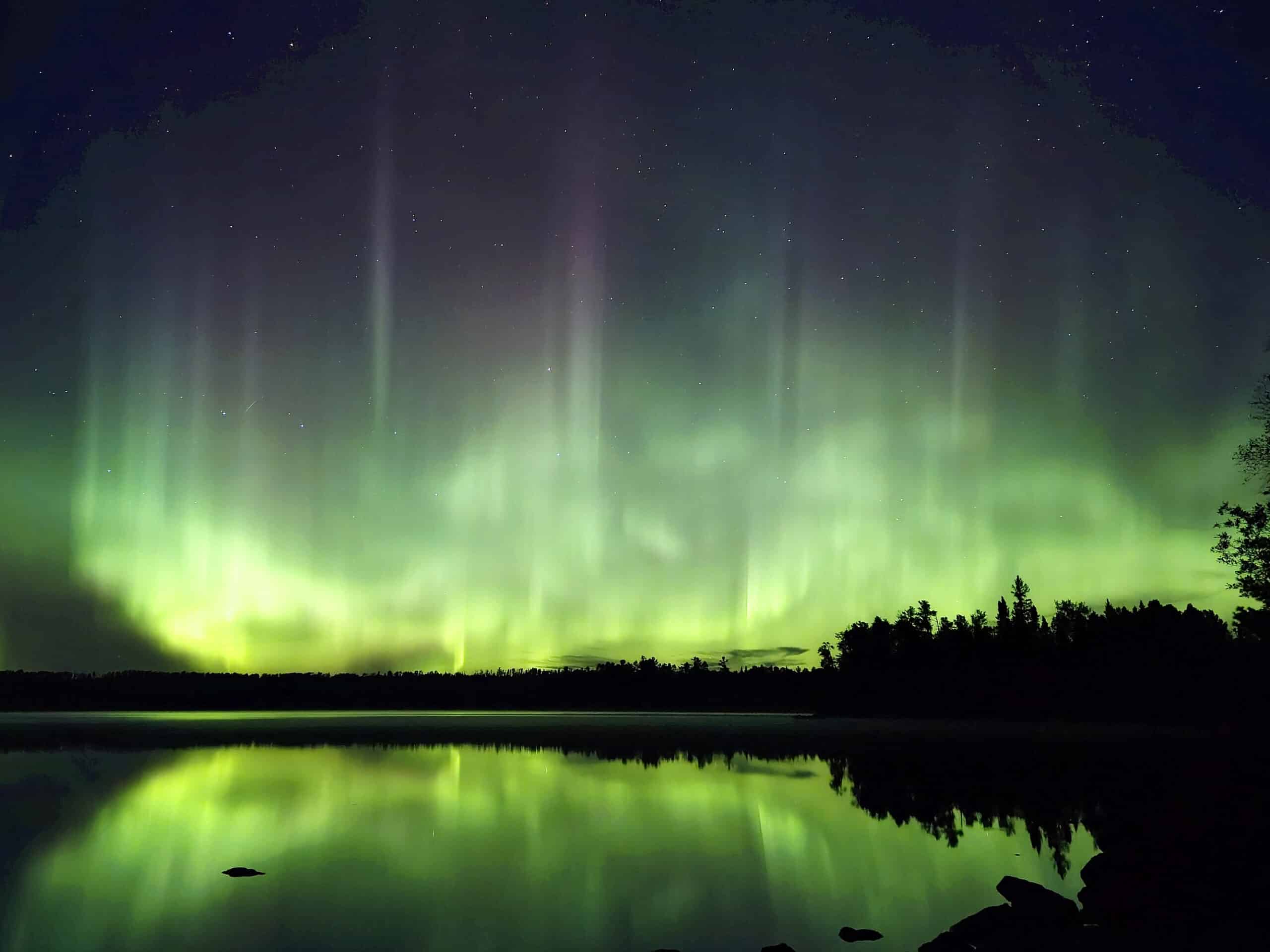
All of that possibility just got pretty overshadowed for us, by the show that the aurora put on!
If you’re interested in possibly seeing the northern lights, check out our posts: Aurora Hunting, How to Photograph the Northern Lights, Can I See the Northern Lights Tonight?, and Where to See Northern Lights in Ontario.
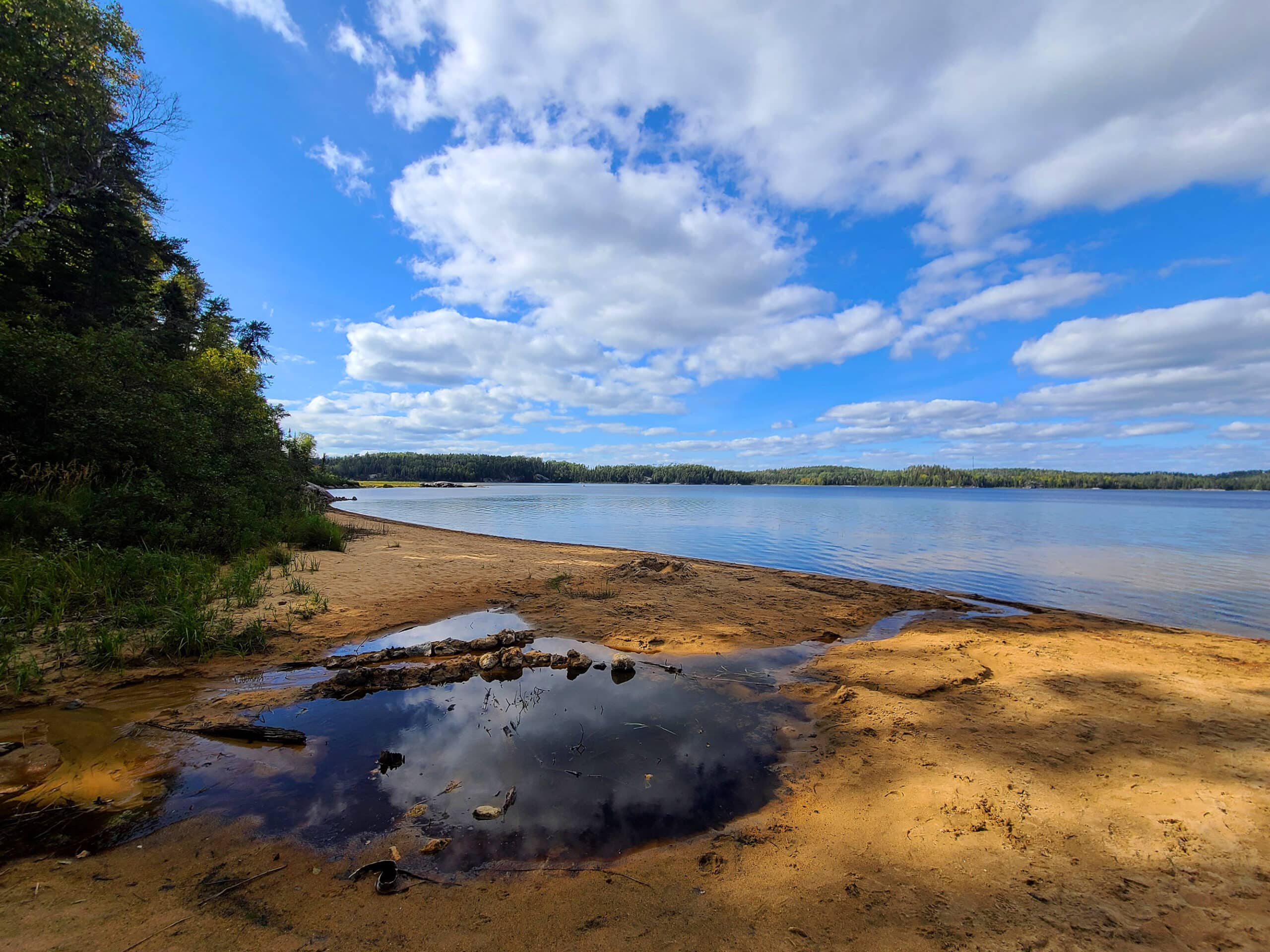
Hiking
There are 35 km of hiking trails accessible to the campground, with a wide range of trail lengths and difficulty ratings.
They’re some of your best opportunities for wildlife viewing in the campground - keep an eye out for moose, white-tailed deer, or even the occasional black bear.
Just be sure to bring some insect repellent - the area is known for black flies, in certain seasons.
In order of distance, here are the trails in the park:
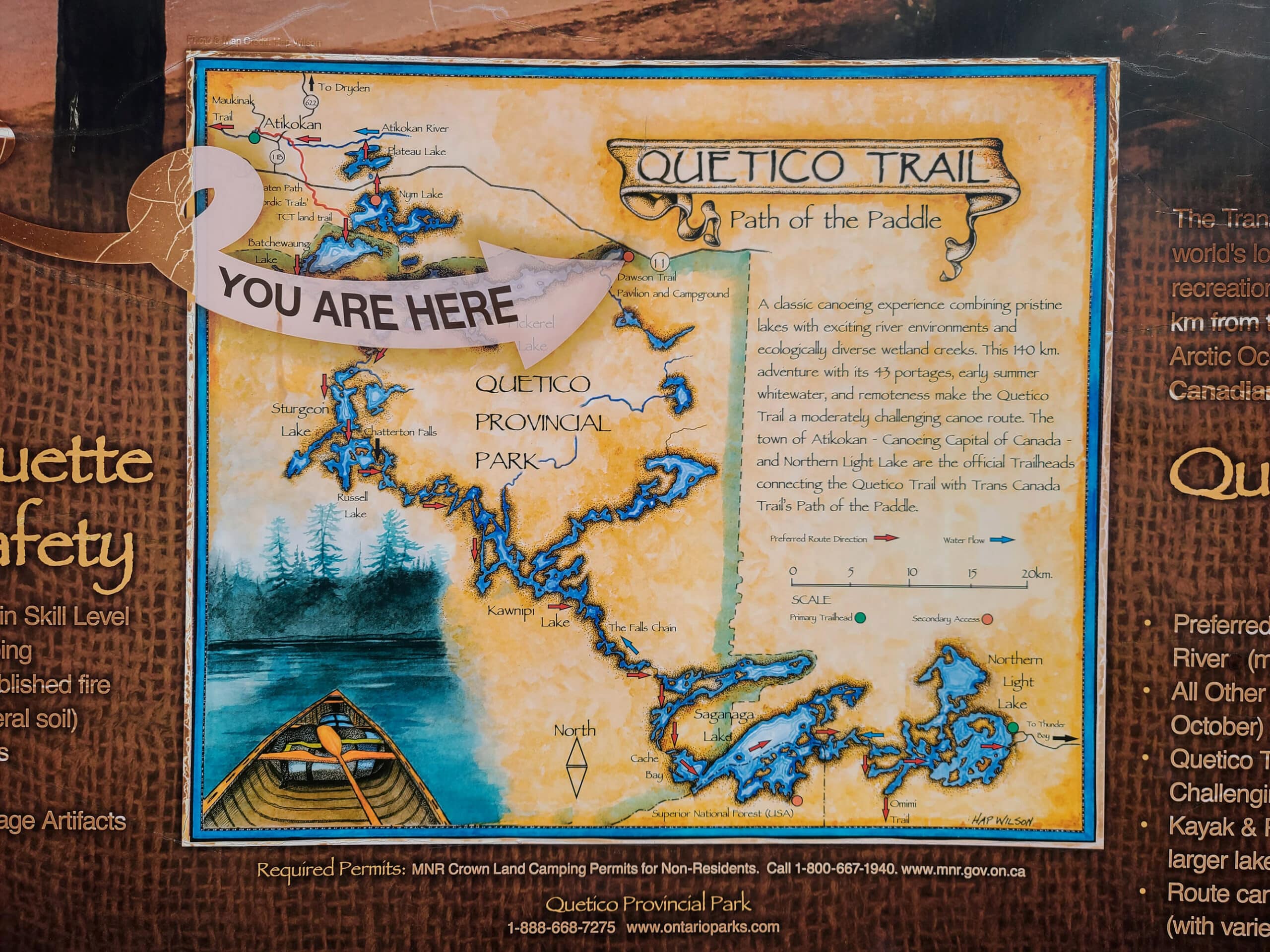
Pines Hiking Trail - Moderate
A 10 km return trail, this one is an extension of the Whiskey Jack Trail, and should take 3.5 hours to complete. It includes moderate to steep climbs and takes you to the sandy beaches of Pickerel Lake.
Porter did the trail in May 2025, here’s what he had to say about it:
“Continuing on from the Whiskey Jack trail, a wood bridge provides a great view of Baptism Creek then goes back into dense forest with occasional elevated views.
Overall this trail is a little less rugged than Whiskey Jack. There are less areas with rough footing, but there are still some steep hills.
Expect multiple areas that are muddy or are completely washed out. The mud did provide me an opportunity to see moose prints, but watch out for moose droppings as there were several areas of them during my walk.”
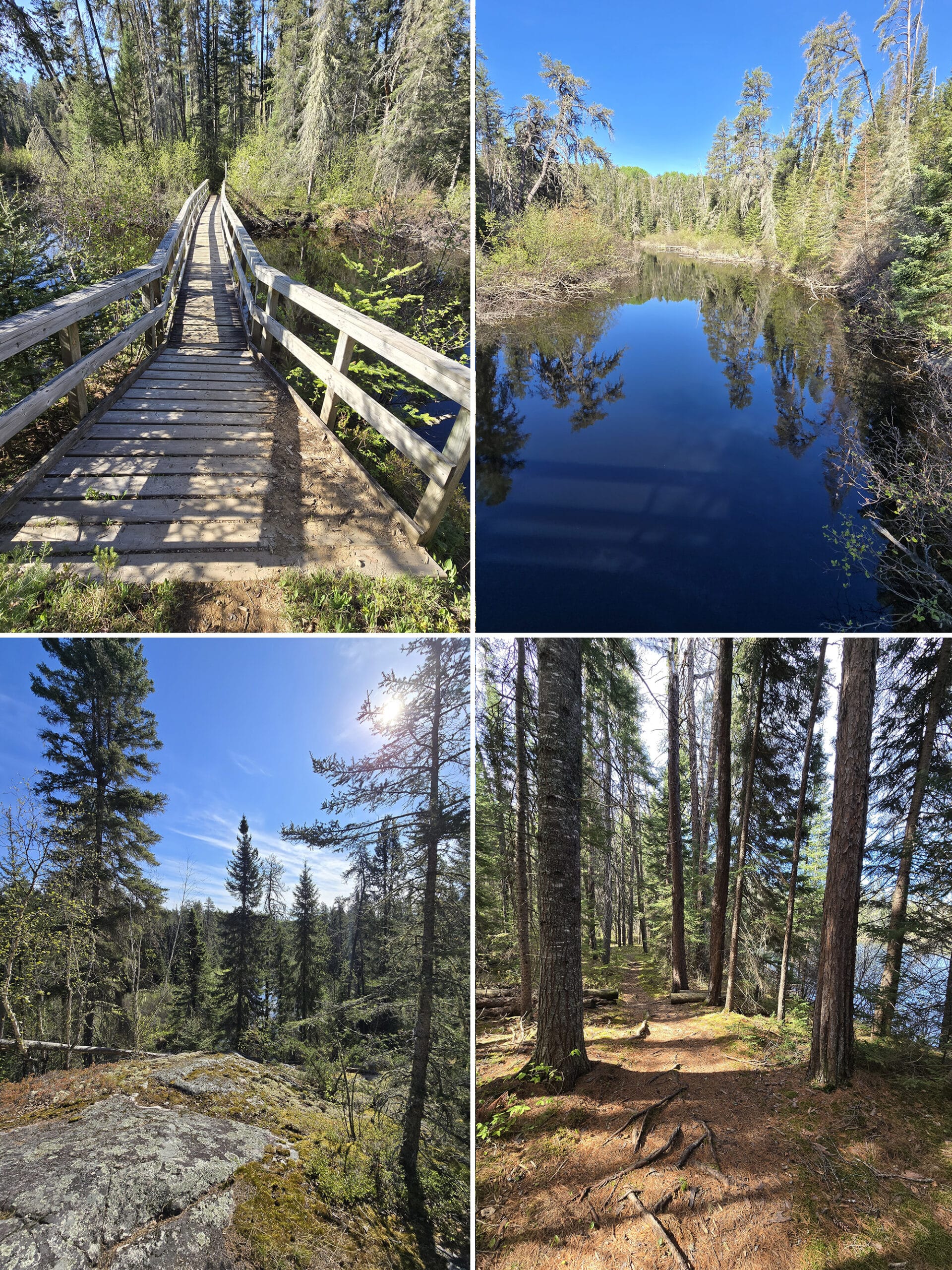
I was pretty sure there would be nobody camping at the back-country sites this time of year, so I took the short paths over to see the camp sites and their great views of the lake.
A couple of kilometers into this trail I considered going back. It's not that it wasn't a nice trail, but knowing it's a there-and-back trail I felt like I had seen all I needed to see. I kept going because I really wanted to see The Pines at the end.”
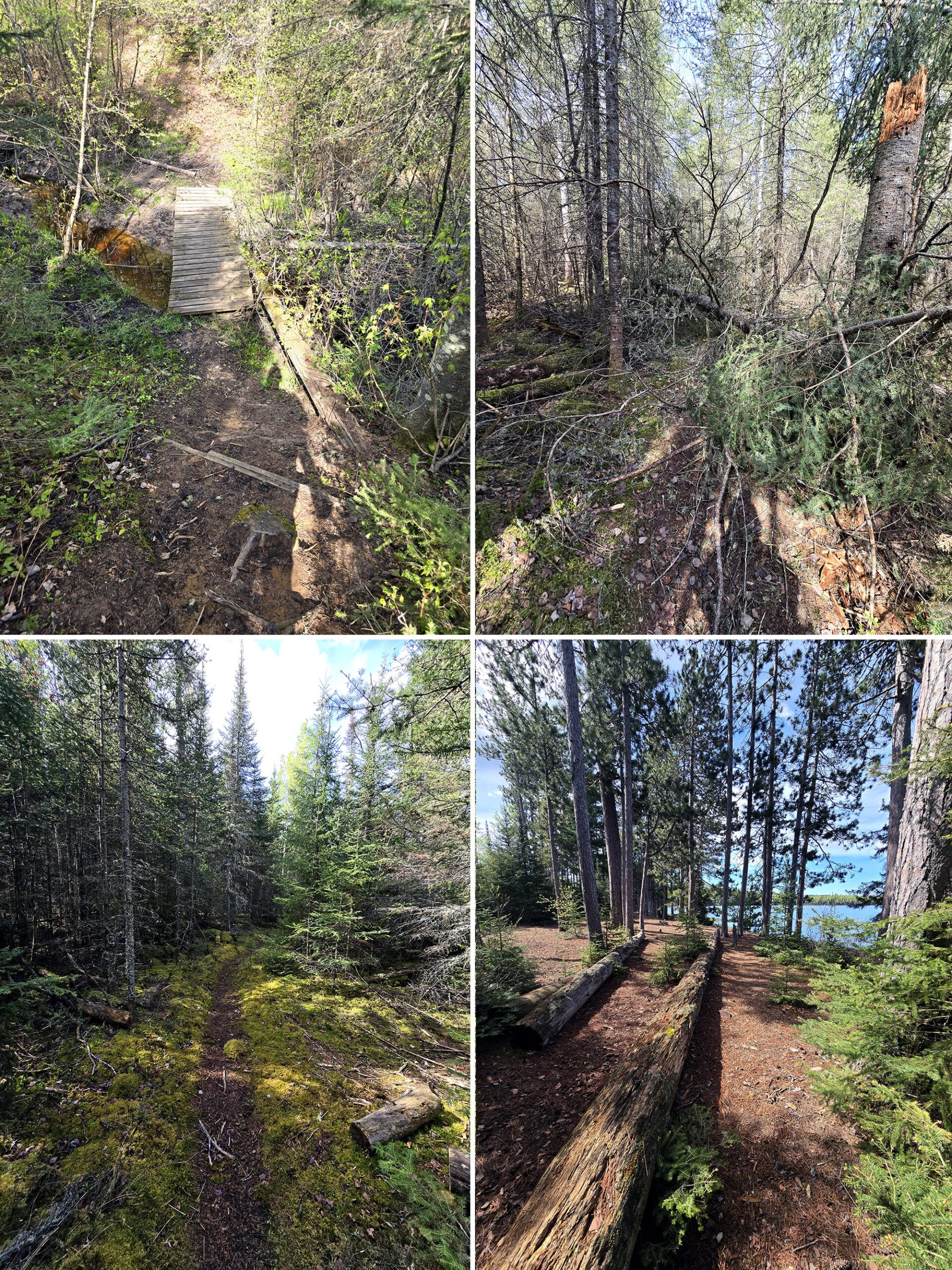
Overall I liked the trail a lot, but it was quite a long distance to go to see The Pines. I'm not sure I would do it again because I know there are several other really nice trails nearby and I think I'd spend my time doing more of the smaller trails rather than doing this one again.”
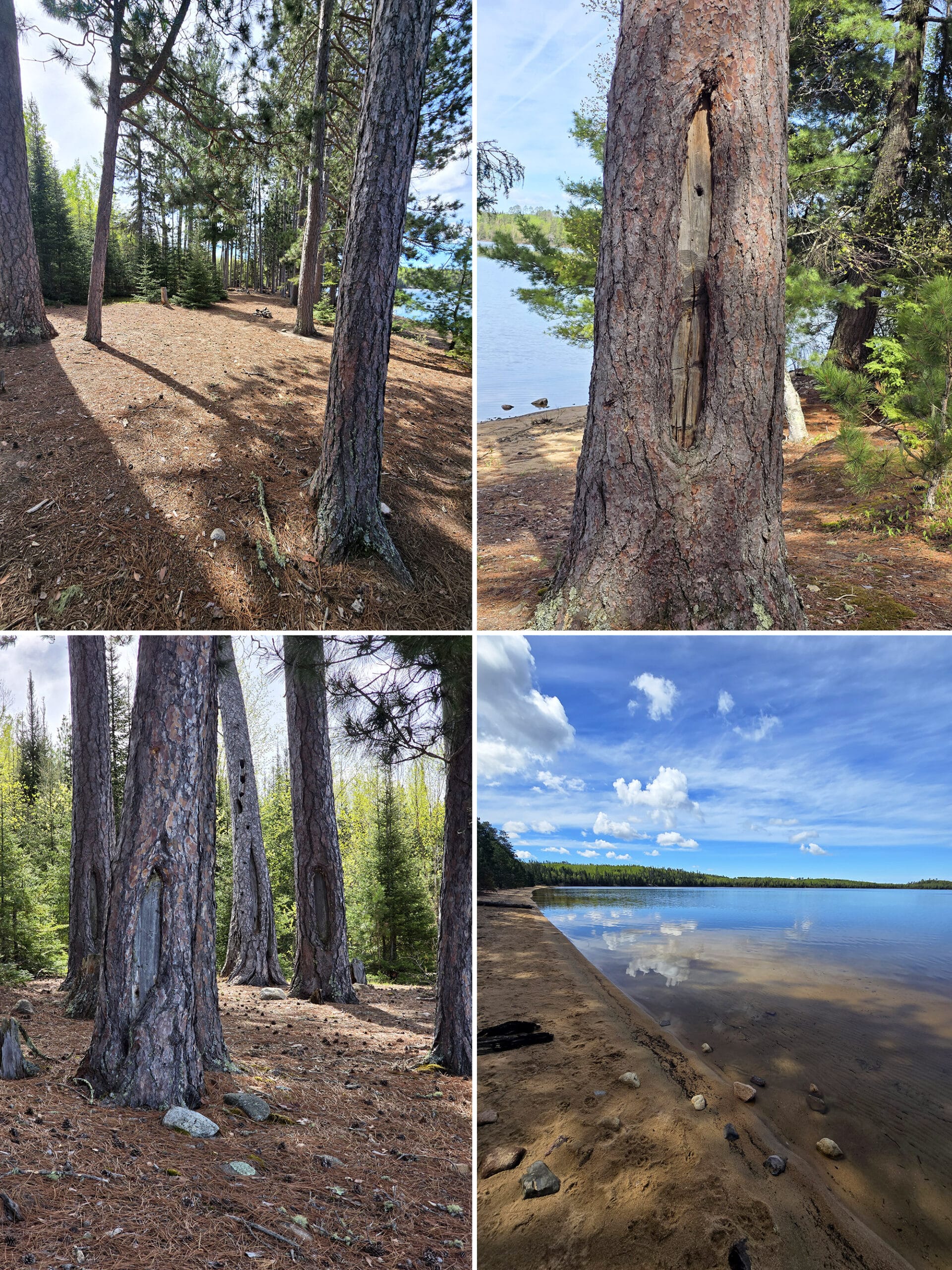
French Portage Trail - Strenuous
This 5 km hike traces an old portage route that was originally used by the First Nations people BEFORE the European explorers and fur traders arrived. It should take you about 2 hours to complete.
Says Porter:
“I skipped the beginning of this trail, linking in where the Teaching Trail ends.
This trail is moderate in difficulty, with a more hilly rough areas of boulders and tree roots. There were some obstructions - downed trees - on the trail during my visit, but they were pretty easy to get around.
For pretty much the entire path I saw fresh moose prints. I'd love to see a moose, but not in late September on a narrow trail!
Luckily, the prints were headed the other direction, so I was less concerned about that particular moose, and kept a close eye out for any more.”
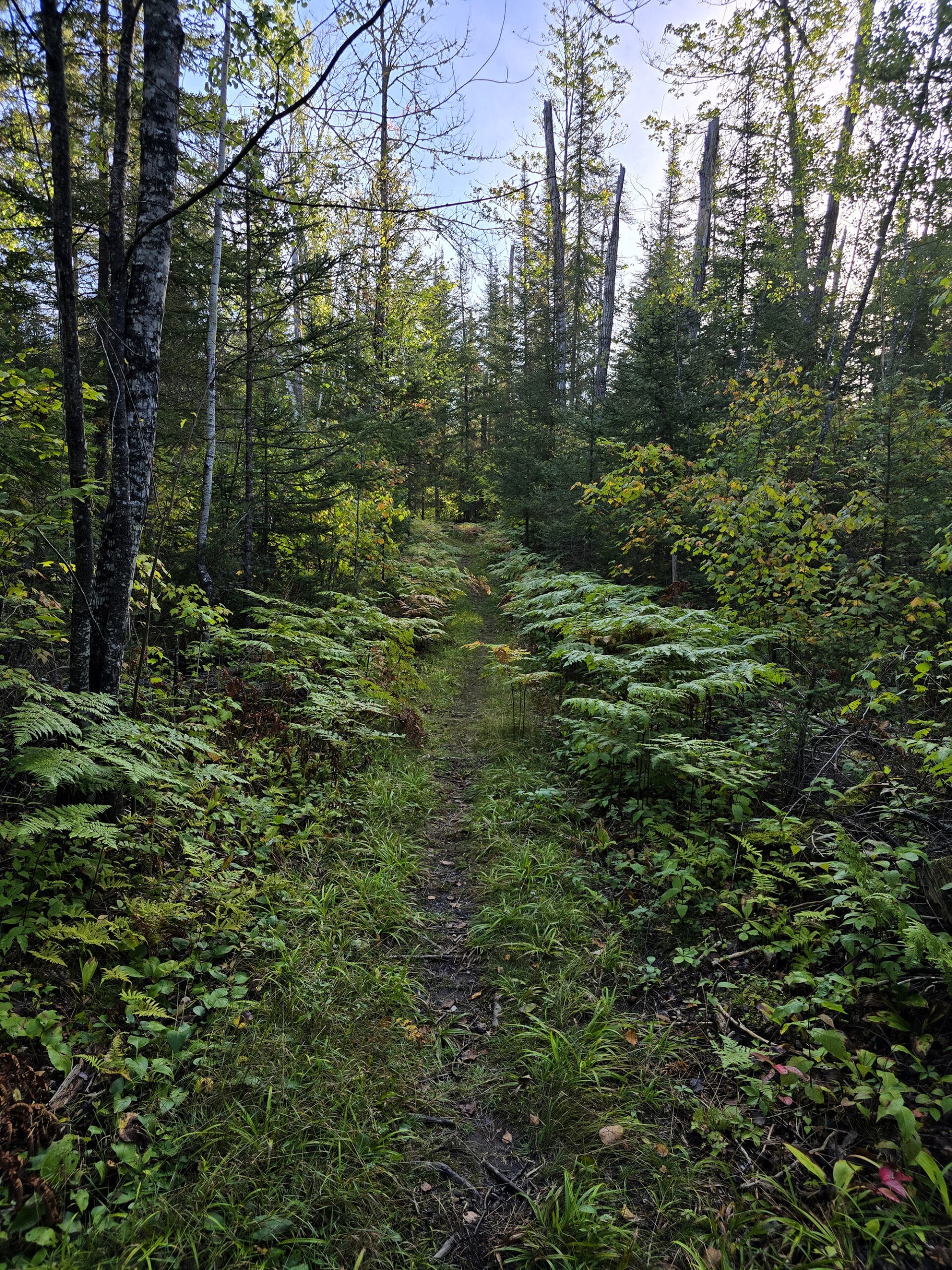
Camp 111 Trail - Moderate
This 4.4 km trail is what’s left of an old logging road. Running adjacent to French River, it takes you through various types of forests.
Porter did the trail in May 2025, here’s what he thought:
It appeared to be younger forest, with smaller trees and bushes to the side, as well as grassy areas.
I saw a day-use area to the side, with a fire pit and some lumber. It looked as though a shelter was going to be built at some point, but the lumber was rather aged, so it appears as if that project was abandoned.
I only saw a little of this trail, but I’m looking forward to doing more of it, on a future trip.”
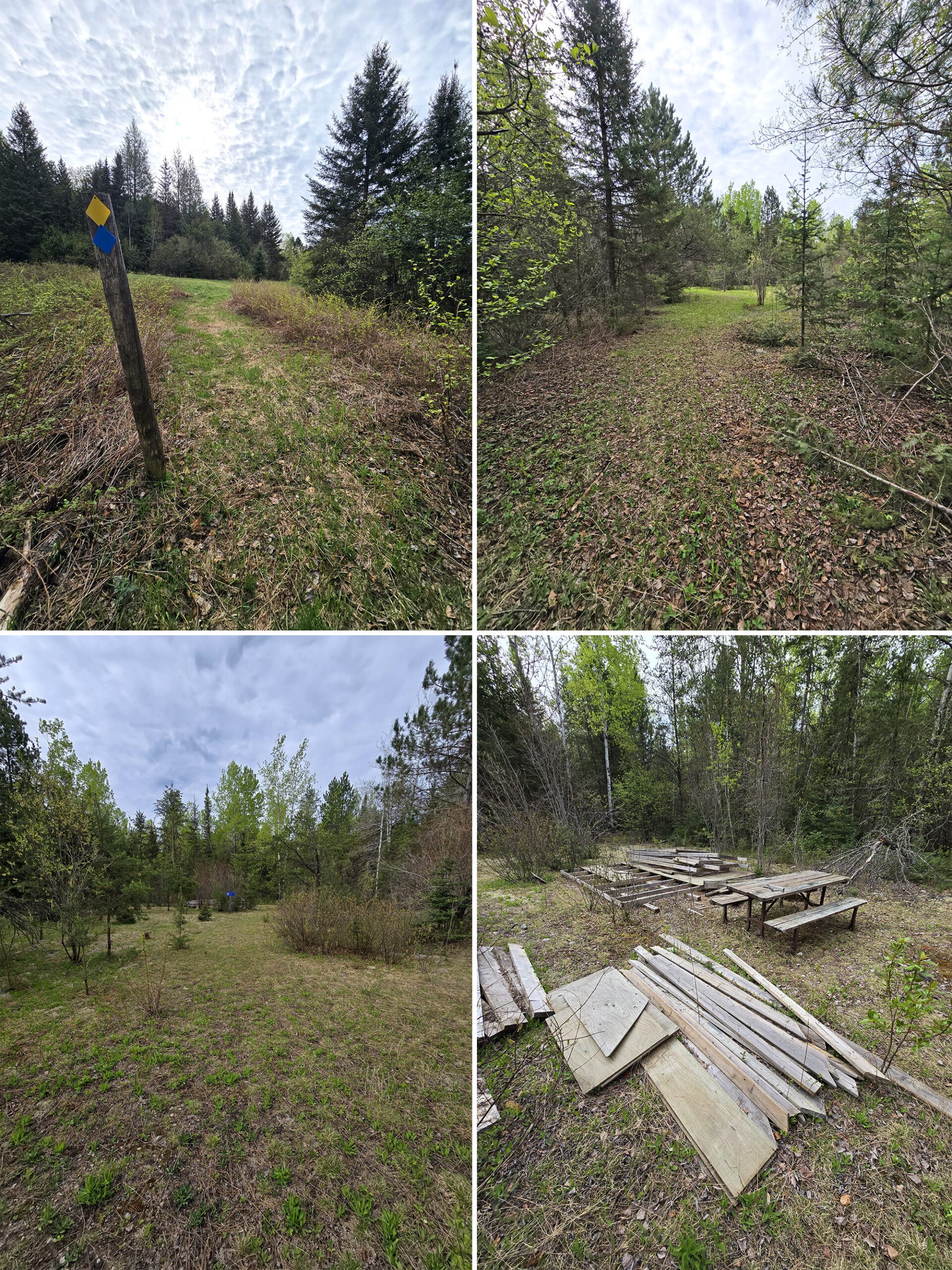
The Teaching Trail - Strenuous
This is a 3.2 km trail that connects the Day Use Area, Chippewa, and Ojibwa campgrounds, weaving through a variety of different terrains, forest types, a meadow, and along the shore of French Lake. It should take 2 hours to complete.
Says Porter:
“I used the East branch of The Teaching Trail to connect to French Portage and French Falls Trails.
This portion is a easy-moderate difficulty, it's not too hilly or rough, just need to watch your step a bit on the sometimes-narrow path. Near the end, however, there's a small section that is a little tough.
The floating dock has a bit of a gap in one section, then that last section doesn't quite meet up with dry ground.
A big step to one side puts you on a grassy patch to keep your feet dry, at least with the water level where it was during our trip. Just beyond that the ground is rather soft for a hundred meters or so.
There are logs laid down for much of it, but some of it is squishy ground. A nice walk through the woods, and a cool view from the long floating dock section.”
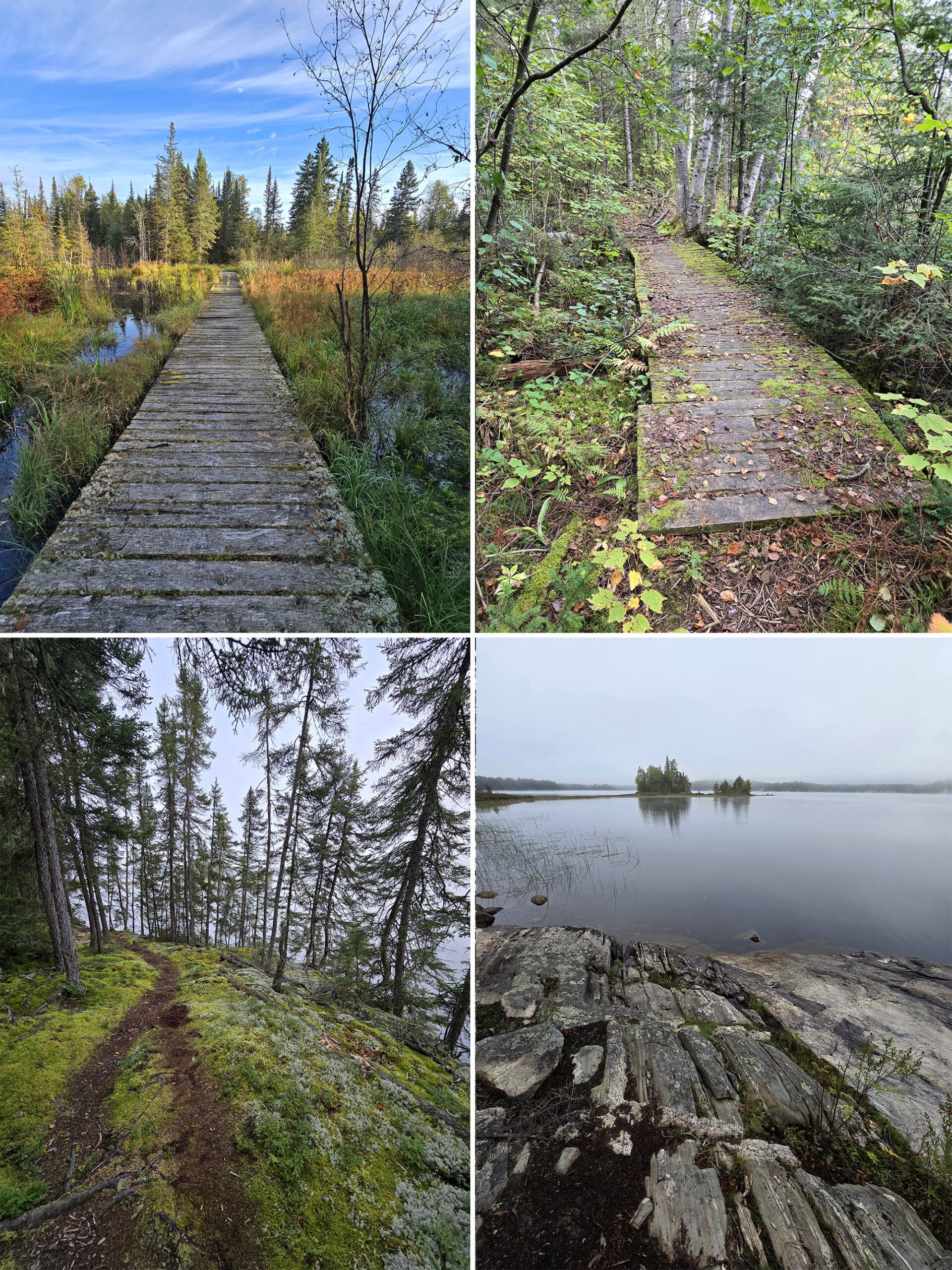
The views are amazing, very diverse! Woods, boulders, lake view, oh my!
Shortly after passing the Teaching Place you'll see a fairly steep hill. If you're not up for a more difficult trail, this is where you should turn around.
At this point the trail gets more difficult, with steeper inclines, narrow path areas, and rougher rocky sections. You get some good elevated views on this part of the trail.
Near the Ojibwa campground the soil turns sandy with roots, and a red squirrel threw pinecones at me from way up in a tree (it's a thing they do to scare you away), so I turned around for the trip back.”
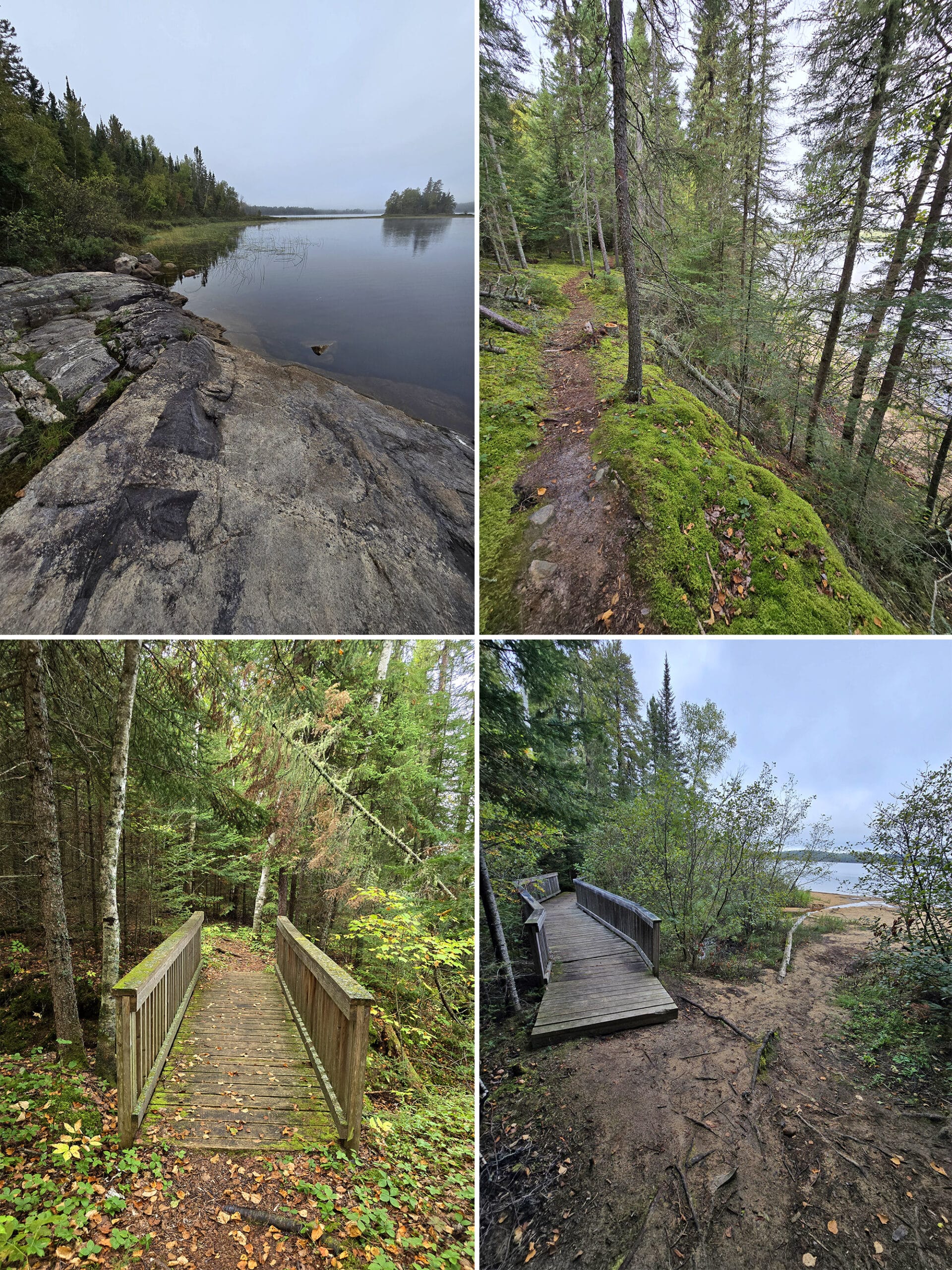
Fisher Trail - Moderate
“When I did the West branch of the Teaching Trail, I opted to take the Fisher Trail when returning. This trail is quite narrow, and looks to be either new or seldom-travelled.
Generally the moss and lichen get rubbed away from rocks on the trail, but in several areas of the Fisher Trail you'll be walking over complete paths of moss and lichen.
It sort of feels like you've lost the trail but you haven't. The path is winding, hilly and rough in areas, making this a difficult trail.
Elevated views are generally pretty obscured by trees. The view looks great by eye since we can easily see through the trees, but when you take a photo from that kind of view it doesn't look spectacular like you'd hope.
A Pileated Woodpecker flew into a tree close by me, I could see him well but couldn't get a good picture through the evergreen trees. He called out, which I took to mean he was laughing at me.
I like the rugged nature of this trail, and I would probably do it again if I was doing another Teaching Trail hike.”
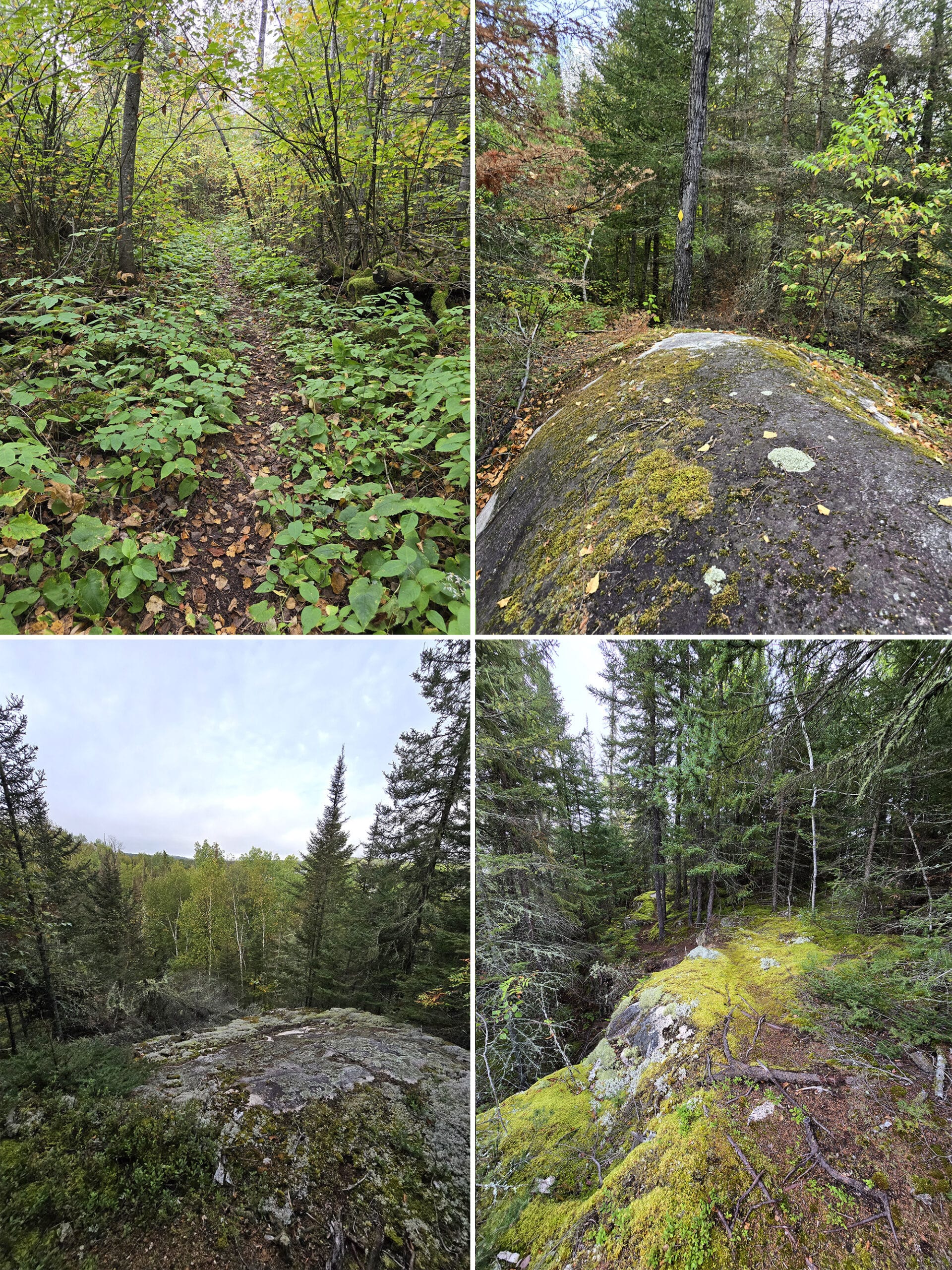
Whiskey Jack Trail - Moderate
A 2.5 km trail, this one starts out on a boardwalk, and winds through forest lowlands that are lush with local flora, like black spruce, bunchberry, horsetail, Labrador Tea, pyrola, tamarack, twinflower, and a variety of mosses. It should take 1 hour to complete.
Says Porter:
You definitely need to watch your step on this trail, and some areas were pretty soft or downright muddy during our visit.
Much of the trail winds along Baptism Creek, with only a couple of side branches bringing you right to the water. I do wish there were more views of the water, I heard a loon nearby but couldn't get a look at it.
This trail was fantastic for birding in late May. Many types of warblers were constantly singing, and several woodpeckers could be heard.
With the winding trail and elevation changes, it's easy to find some spots with great lighting for viewing and photos.”
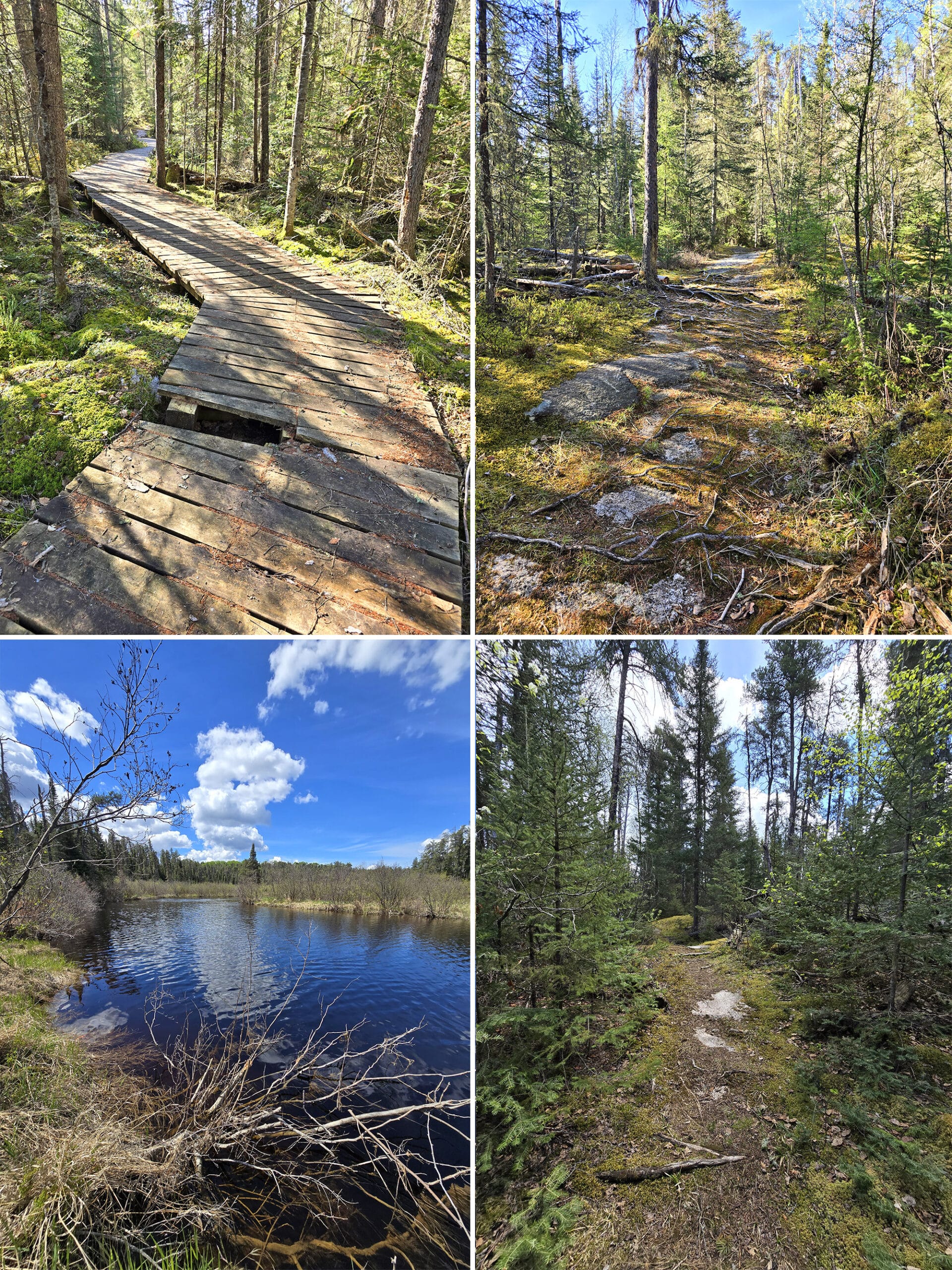
French Falls Trail - Strenuous
This trail is 2.4 km long, and involves steep climbs. Known as one of the most Instagrammable trails in the park, it takes you to the cascades of French River. Suggested completion time is 1 hour.
Says Porter:
“The French Falls Trail gets a bit more difficult yet, definitely well into the "moderate" category. Some sections are a bit easier, such as areas that travel through tall skinny pine trees.
One part passes a swampy section, I'm guessing it's been altered by beavers since there were a lot of dead trees in the swamp and I saw a bit of running water feeding into the swamp.
Some gravel has been added to the trail in a few areas to make it more stable. It follows along the Camp 111 trail for a short stretch, then breaks away toward the river. That's where this trail moves into the "difficult" category.
A narrow path with steep sections, large tree roots, and large jagged rocks make this challenging. It's a really nice hike though, keep going for the falls!
I kept thinking to myself about how this section is a canoe portage, and how difficult this would be trying to carry a canoe and gear over this stretch.”
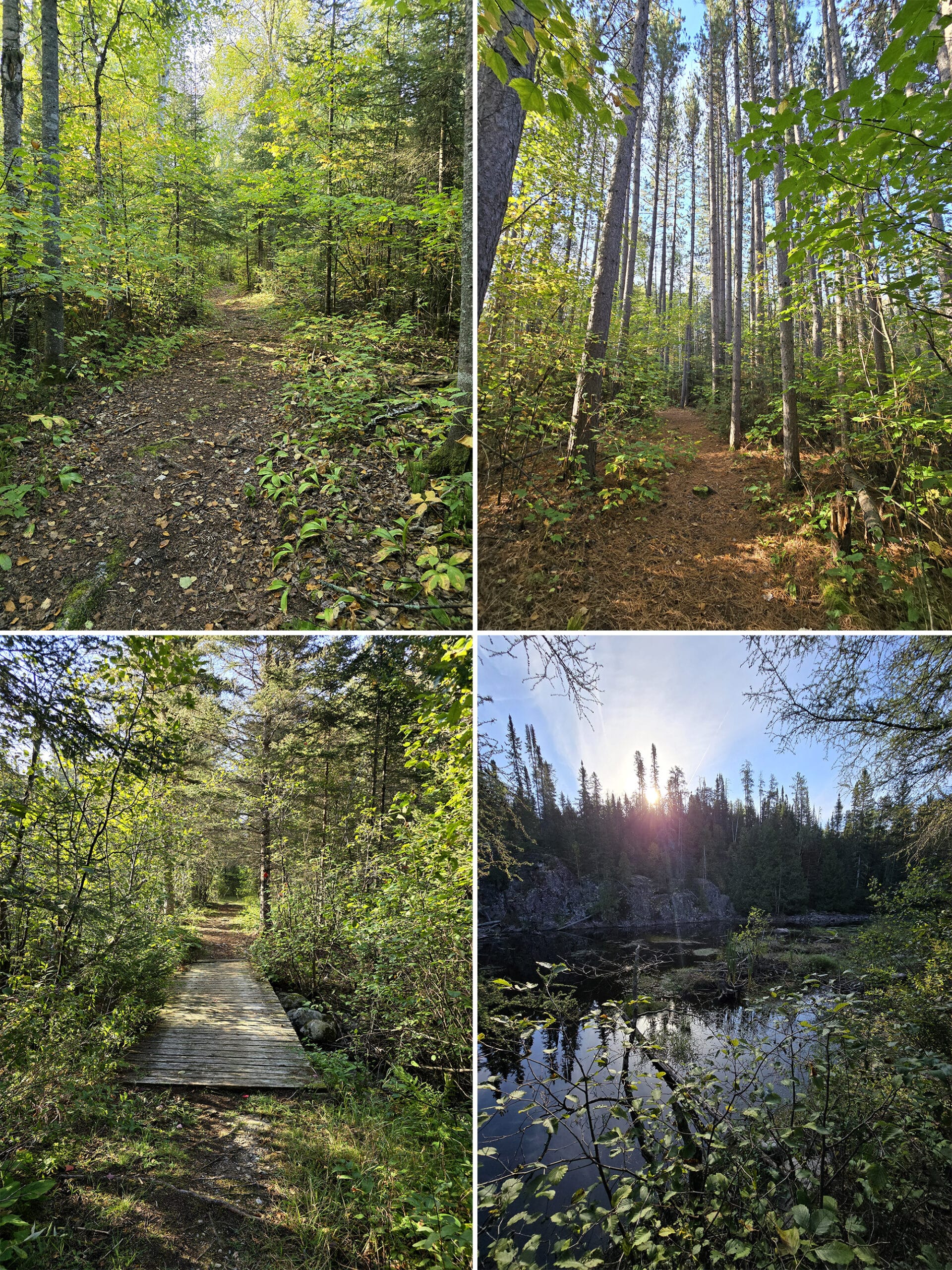
Down a short hill and you are at a lovely waterfall! A bench and a couple of large boulders make for great views while you rest for the return trip.
The portage route followed the river to the right, but I only went down it a short distance.
At this point I was at about 4 ½ km from our campsite, so it was a 9 km hike overall.”
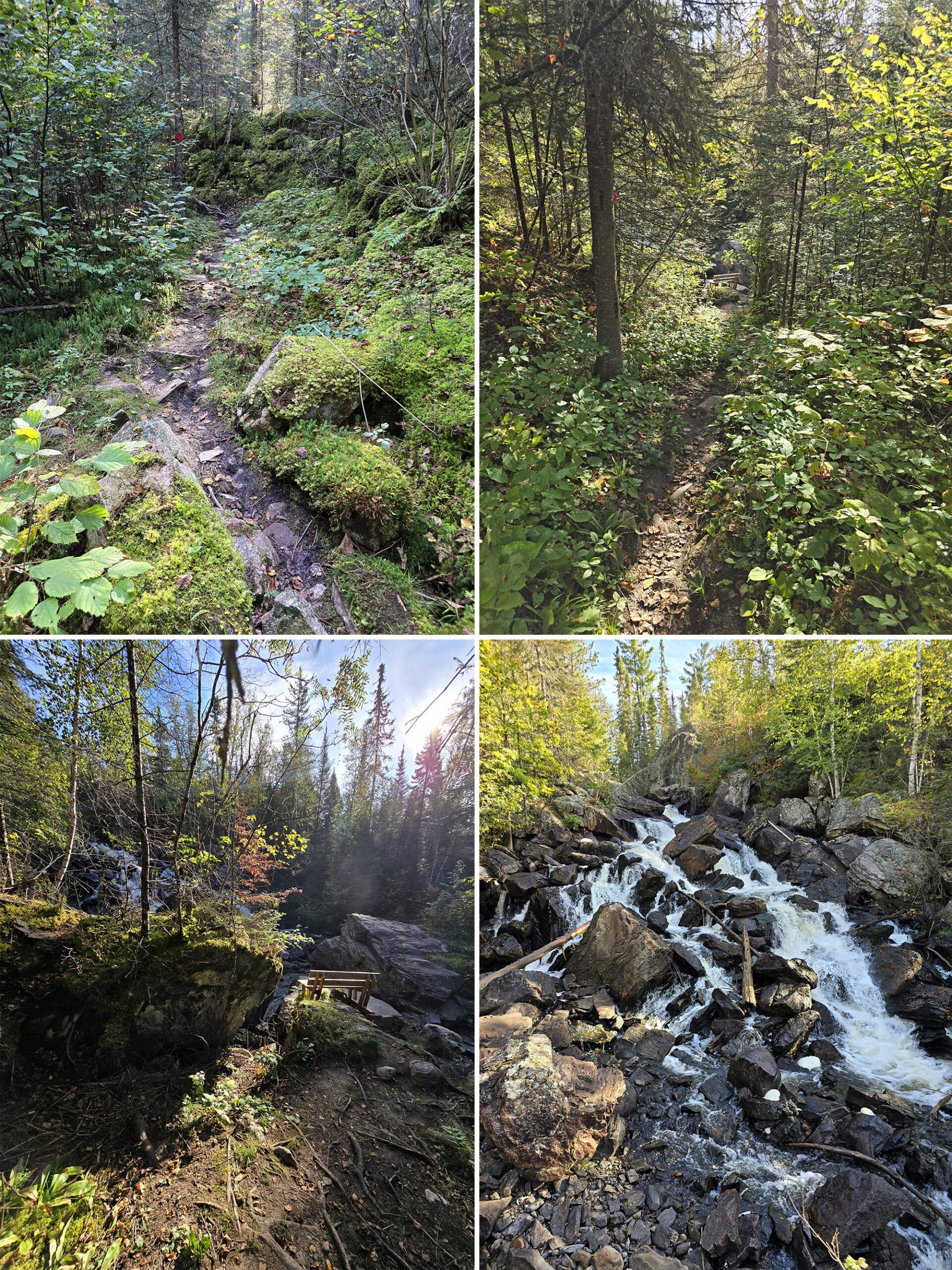
Paul Kane Trail - Easy to Moderate
This is a relatively easy trail for the most part. The first 100 metres or so is a little more moderate - steeper incline, rocks, etc, but then it’s a straight, relatively flat, easy walk out to ALMOST the end.
At that point, you turn off the main trail - which continues on to the French Portage trail - and walk down a bit of an embankment to come to the side of the river.
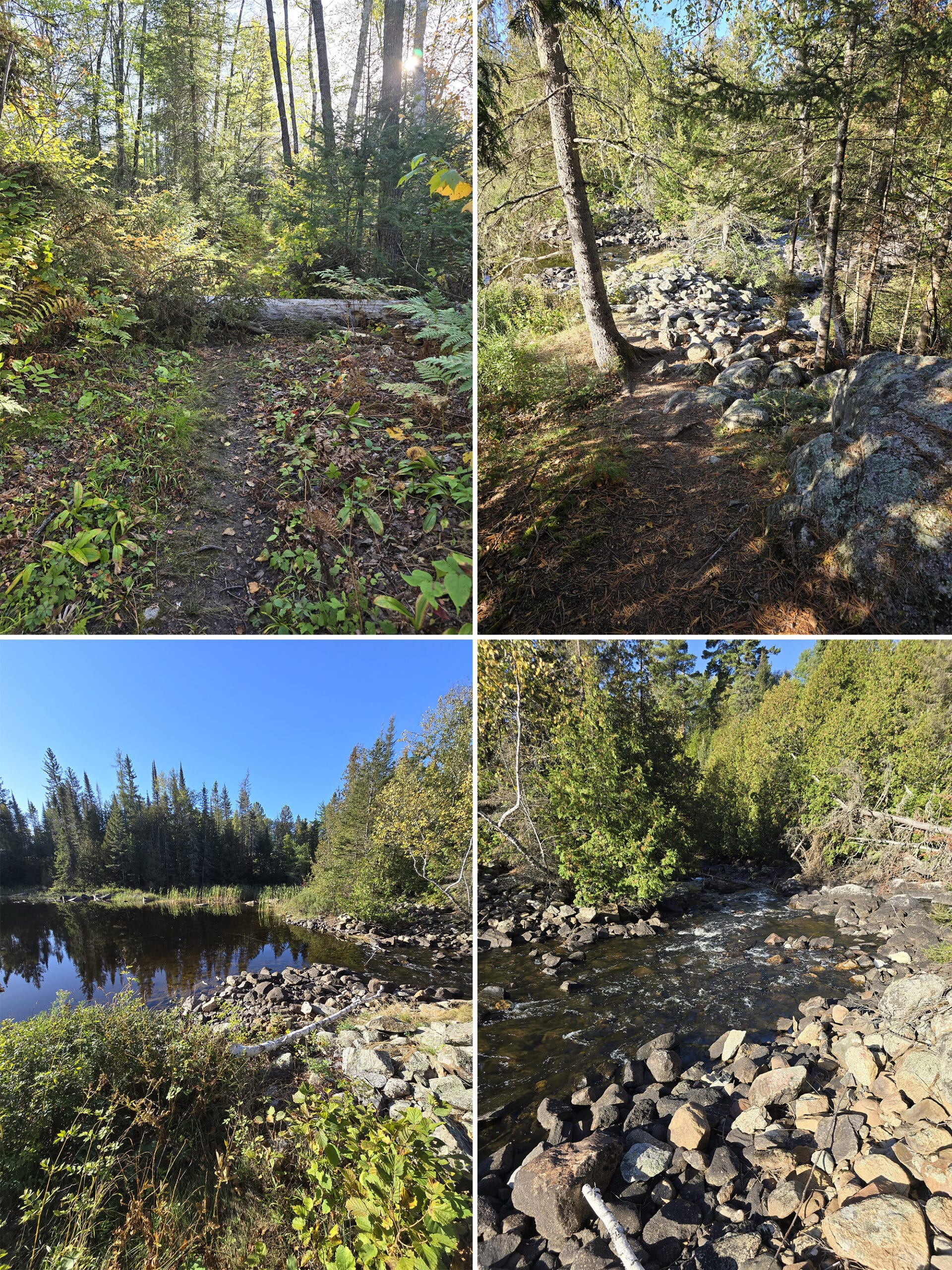
The bulk of the trail is a pretty basic, plain walk through the woods. The very end - after you turn off - is more difficult, but gorgeous and much more ADHD friendly.
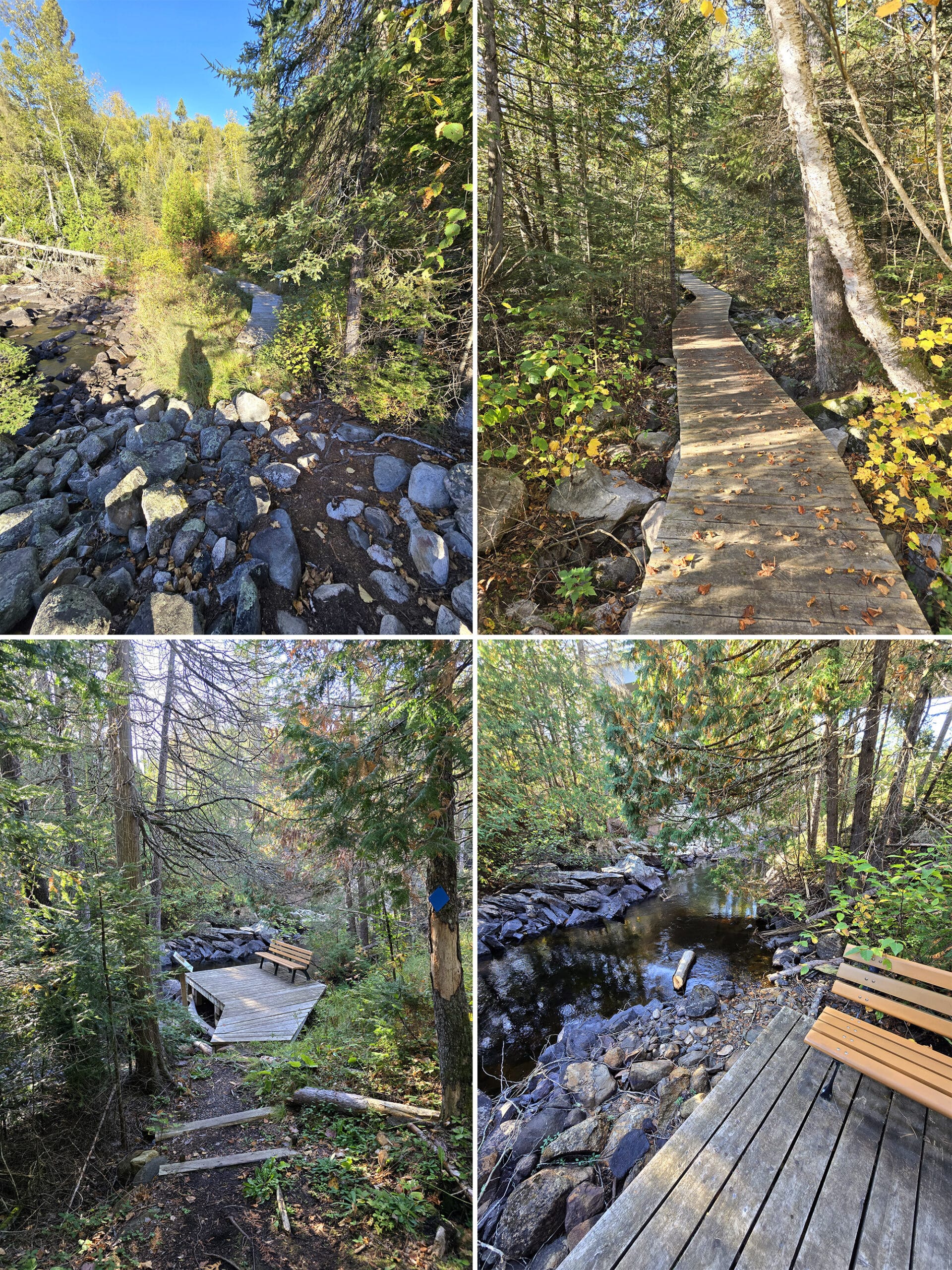
Pickerel Point Trail - Moderate
This trail is a 0.6 km loop, and is the only trail designated as a pet exercise area. At times difficult - it has some steep sections - the trail follows the Pickerel River.
We did this as an extension of a walk along the boardwalk trail.
It starts out as a trailhead on the road from the day use area, and takes you down to - and along - the Pickerel River.
I’d say it’s between easy and moderate. There are some sections with uneven footing, but it’s not like a *workout* like some moderate trails are. Plus, it’s quite short.
Also, a chunk of the trail - from the dog beach back to the trail head - is on a dirt road.
Overall, a nice morning hike. Had we been there a couple hours earlier, I bet it would have been a great place to look for moose or other people-adverse wildlife.
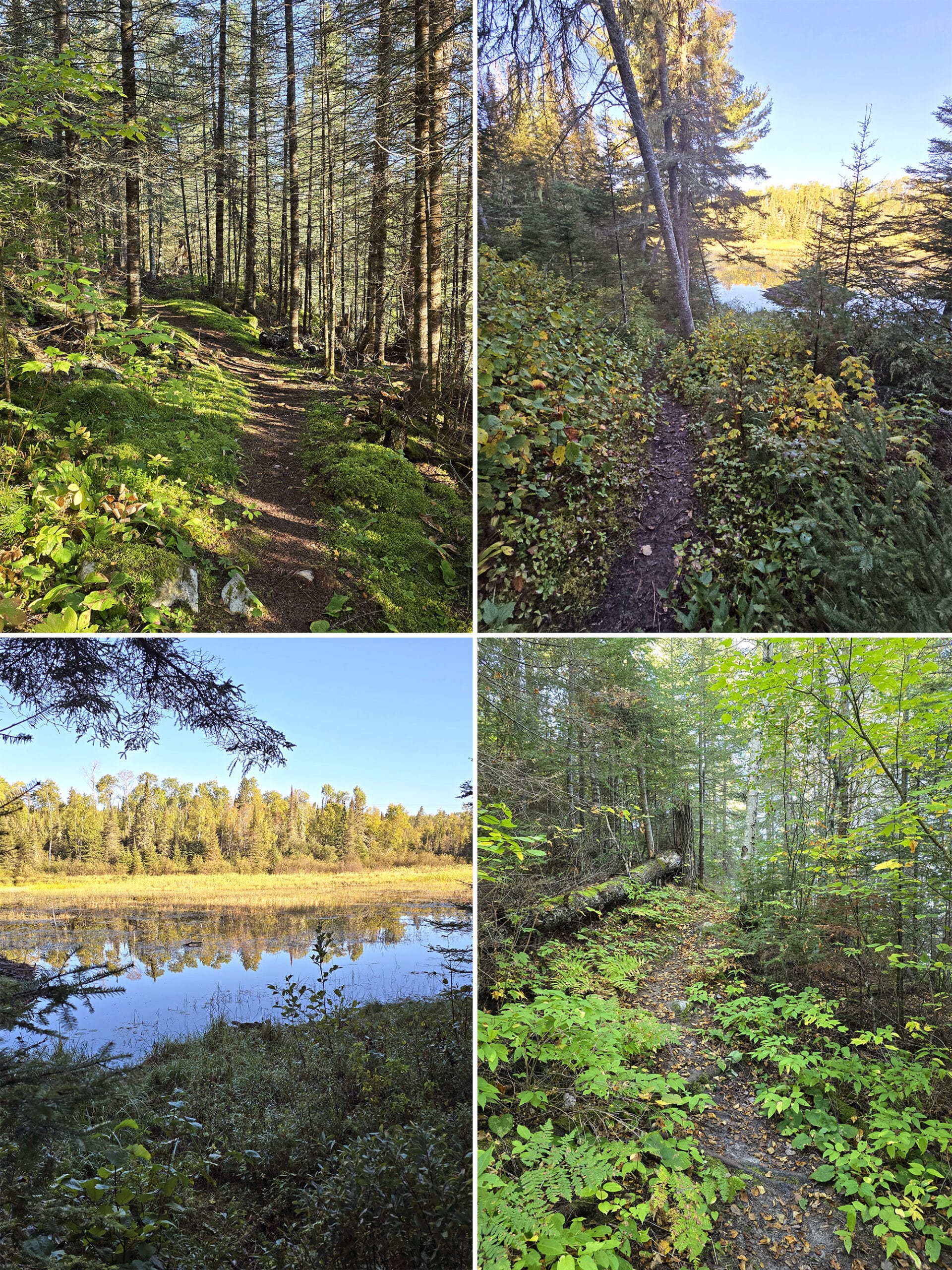
Baptism Creek Trail - Moderate
This trail is 1.1 km long, taking you through a stand of pine trees before ending on the bank of Baptism Creek. Should take 30 minutes to complete.
Porter did the trail in May 2025, here’s what he thought:
“This trail is wider than much of the Whiskey Jack trail, presumably due to it being a cross-country ski trail in winter. It winds through different types of forest and grassy areas, with some boardwalk bridges as well.
I was disappointed that it didn't offer many good views of Baptism Creek, given the name. It has multiple areas with rather steep elevation changes, and rough footing in some areas. I would classify this as moderate, as you have to watch your step.
Although I liked this trail, I do prefer the Whiskey Jack trail.”
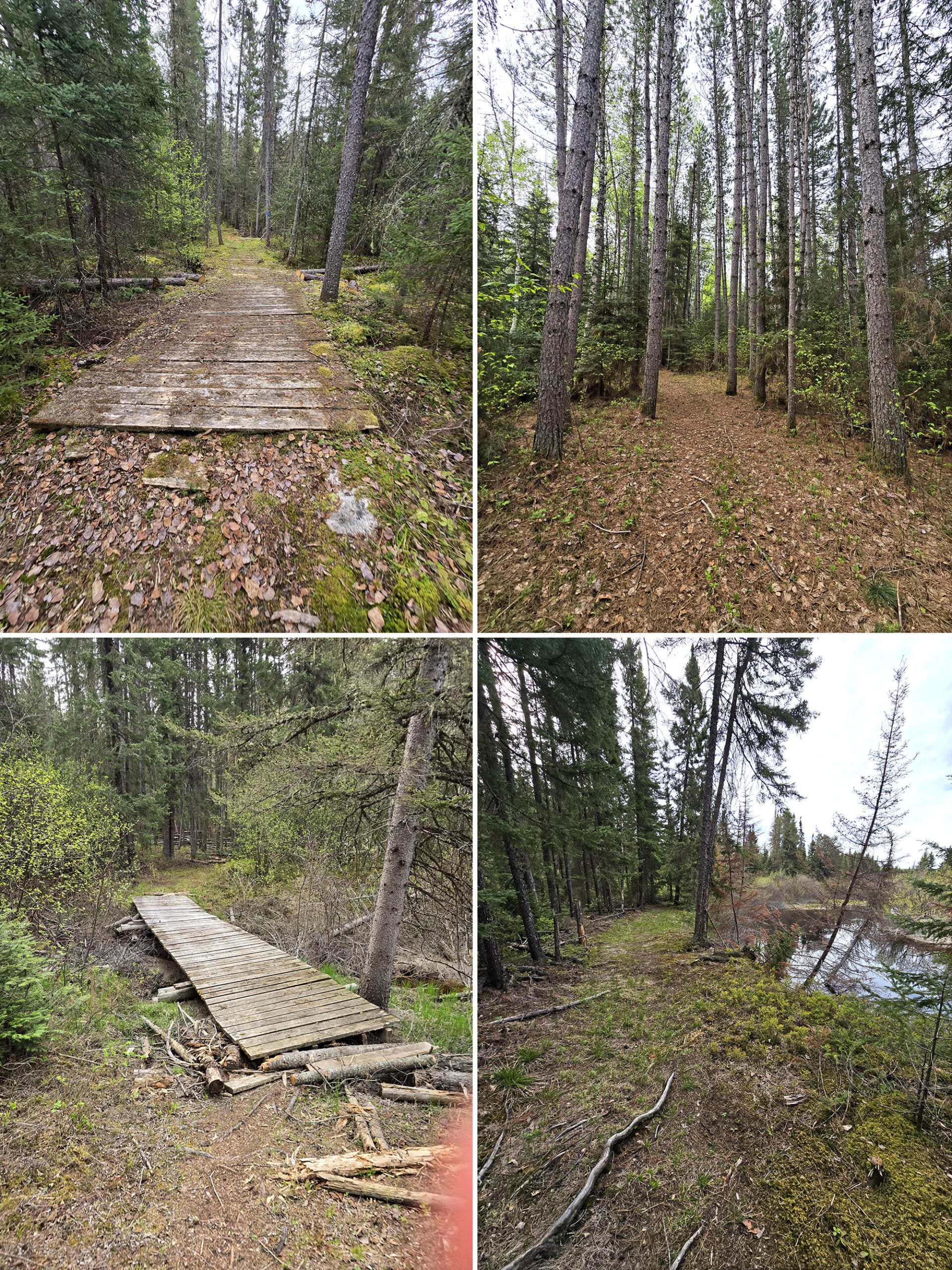
Pickerel River Trail - Easy
This trail is very short - just 0.8 km - and barrier free! It’s a boardwalk the whole way - flat, level, and with traction!
It starts out at the Visitor Center / front office, and takes you along a river’s edge, through some forested areas, and opens out onto the French Lake day use area.
Should take 30 minutes to complete.

Biking
While there aren’t any actual bike paths or mountain biking trails in the park, visitors are invited to go cycling on the Dawson Trail Campground roads if they like.
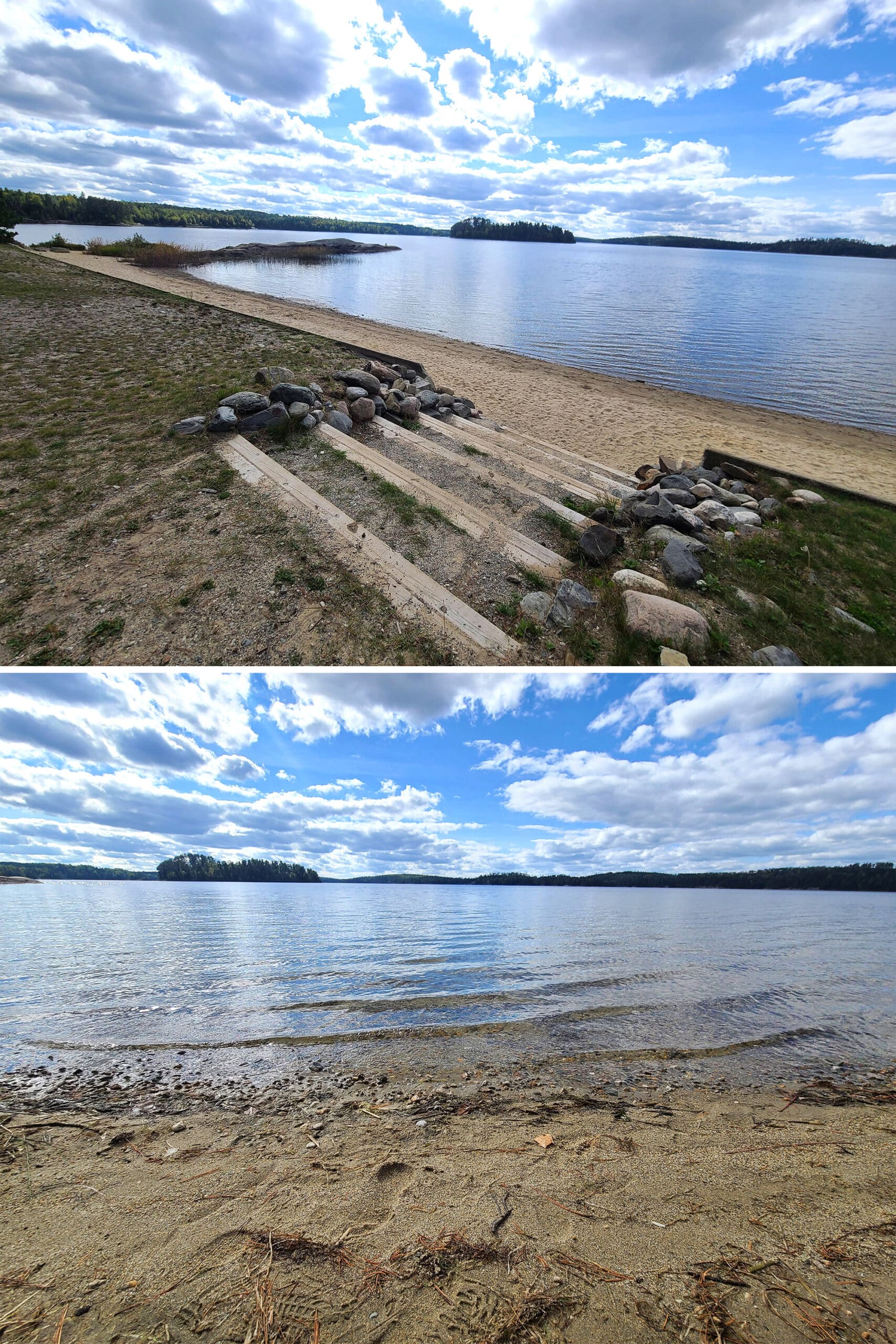
Swimming
We didn’t know what to expect from beaches this far north, but they were gorgeous!
The sand of the beach by the canoe parking was kind of orange, and looked really cool - this was “sandy” sand, rather than very gravelly.
I bet it’s an amazing place to swim in the summer months!

Birding, Wildlife, and Nature
Quetico is home to over 100 species of birds that nest there, and is known as a major breeding ground for bald eagles, osprey, and some other birds of prey.
Beyond those nesting there, over 100 other bird species have been spotted in the park. We didn’t see many birds during our 2023 trip.
During our fall 2024 trip, there were lots of Ruffed Grouse, including two that kept visiting us at our campsite. Beyond that, we heard and/or saw:
American Crow, American Pipit, American Robin, Black-Backed Woodpecker, Black-Capped Chickadee, Blue Jay, Brown Creeper, Canada Goose, Common Grackle, Common Loon, Common Merganser, Common Raven, Downy Woodpecker, Golden-Crowned Kinglet, Hairy Woodpecker, Northern Waterthrush, Palm Warbler, Pileated Woodpecker, Red-Breasted Nuthatch, Red-Necked Grebe, Ruffed Grouse, Ruby-Crowned Kinglet, Swamp Sparrow, Trumper Swan, White-Throated Sparrow, Winter Wren, Yellow-Rumped Warbler.
During those 4 days, we heard and/or saw:
American Crow, American Pipit, American Redstart, American Robin, Bay-Breasted Warbler, Belted Kingfisher, Black-and-White Warbler, Black-Backed Woodpecker, Black-Capped Chickadee, Blackburnian Warbler, Blackpoll Warbler, Black-Throated Blue Warbler, Black-Throated Green Warbler, Blue-Headed Vireo, Blue Jay, Broad-Winged Hawk, Brown Creeper, Canada Goose, Canada Jay, Canada Warbler, Cape May Warbler, Cedar Waxwing, Chestnut-Sided Warbler, Chipping Sparrow, Common Goldeneye, Common Grackle, Common Loon, Common Raven, Common Yellowthroat, Dark-Eyed Junco, Golden-Crowned Kinglet, Great Horned Owl, Hairy Woodpecker, Hooded Merganser, Least Flycatcher, Magnolia Warbler, Merlin, Mourning Warbler, Nashville Warbler, Northern Parula, Northern Waterthrush, Orange-Crowned Warbler, Ovenbird, Pileated Woodpecker, Pine Siskin, Purple Finch, Red-Breasted Nuthatch, Red-Eyed Vireo, Rose-Breasted Grosbeak, Ruby-Crowned Kinglet, Ruffed Grouse, Song Sparrow, Spruce Grouse, Swainson’s Thrush, Swamp Sparrow, Tennessee Warbler, Warbling Vireo, White-Crowned Sparrow, White-Throated Sparrow, Wilson’s Snipe, Wilson’s Warbler, Winter Wren, Yellow-Bellied Flycatcher, Yellow-Bellied Sapsucker, Yellow-Rumped Warber, Yellow Warbler.
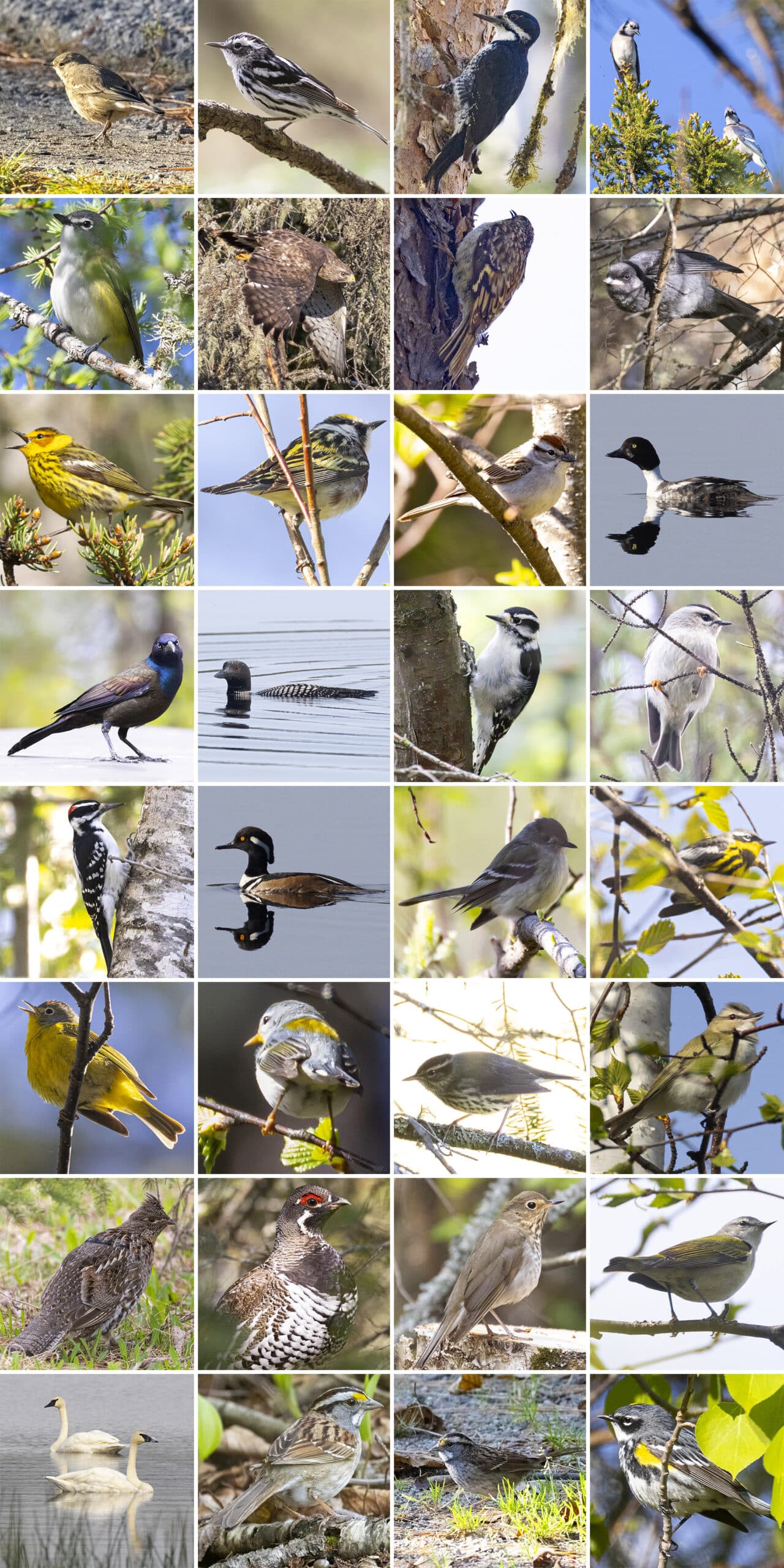
Row 2: Blue-Headed Vireo, Broad-Winged Hawk, Brown Creeper, Canada Jay
Row 3: Cape May Warbler, Chestnut-Sided Warbler, Chipping Sparrow, Common Goldeneye
Row 4: Common Grackle, Common Loon, Downy Woodpecker, Golden-Crowned Kinglet
Row 5: Hairy Woodpecker, Hooded Merganser, Least Flycatcher, Magnolia Warbler
Row 6: Nashville Warbler, Northern Parula, Northern Waterthrush, Red-Eyed Vireo
Row 7: Ruffed Grouse, Spruce Grouse, Swainson's Thrush, Tennessee Warbler
Row 8: Trumpeter Swan, White-Throated Sparrow, White-Throated Sparrow (whoops!), Yellow-Rumped Warbler
Also, during our fall 2024 trip... there were SO many different types of fungi!
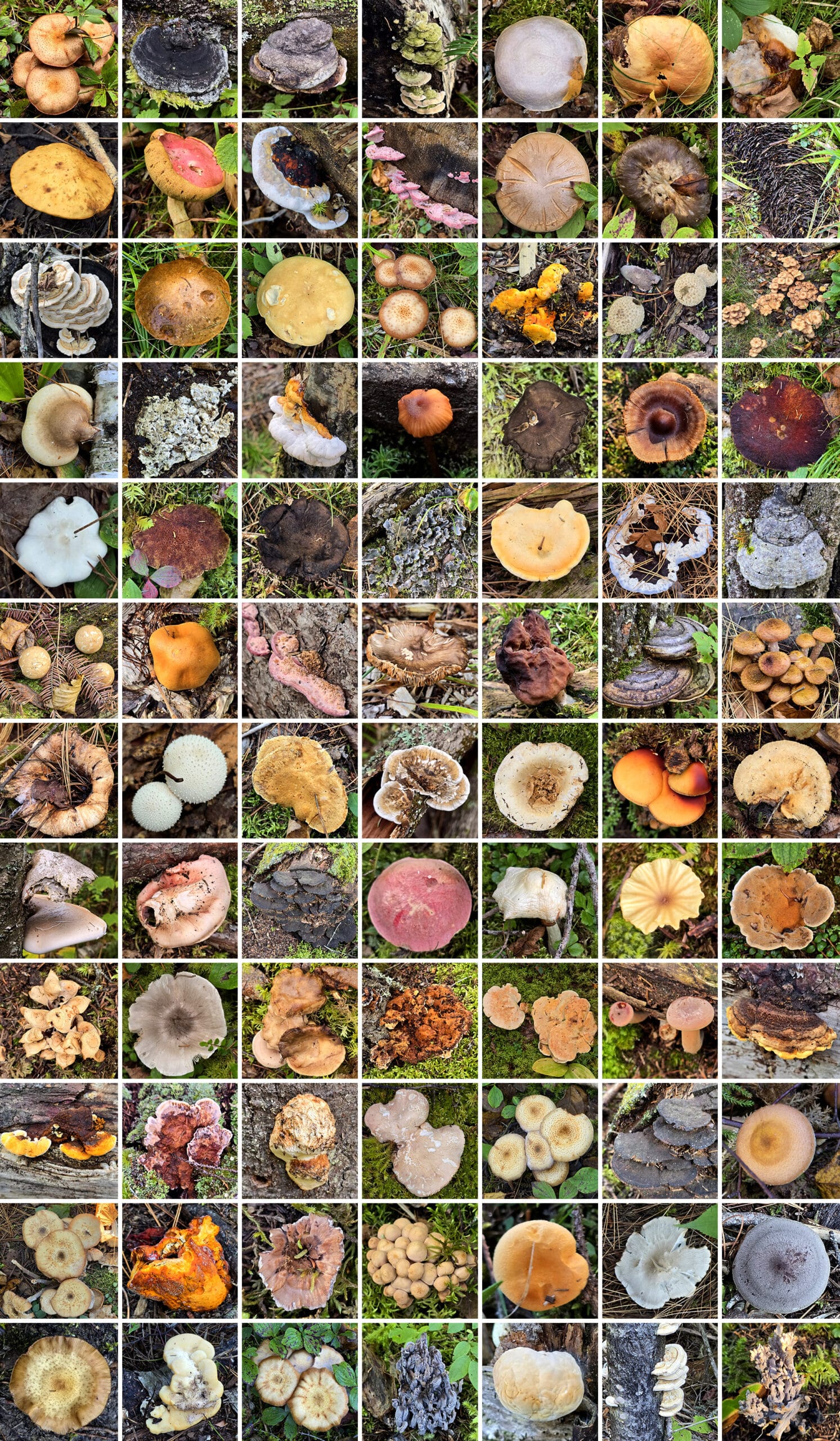
Canoeing
Just north of Minnesota's Boundary Waters Canoe Area, it’s no surprise that the picturesque rivers of Quetico are a prime destination for those who enjoy a long canoe trip.
The vast majority of the park - everything except Dawson Trail - is ONLY accessible by water - no roads at all!
The hundreds of interconnected lakes and rivers - with over 500 designated, maintained portages - provide virtually unlimited canoe route options for those with paddling arms and a waterproof map on hand.
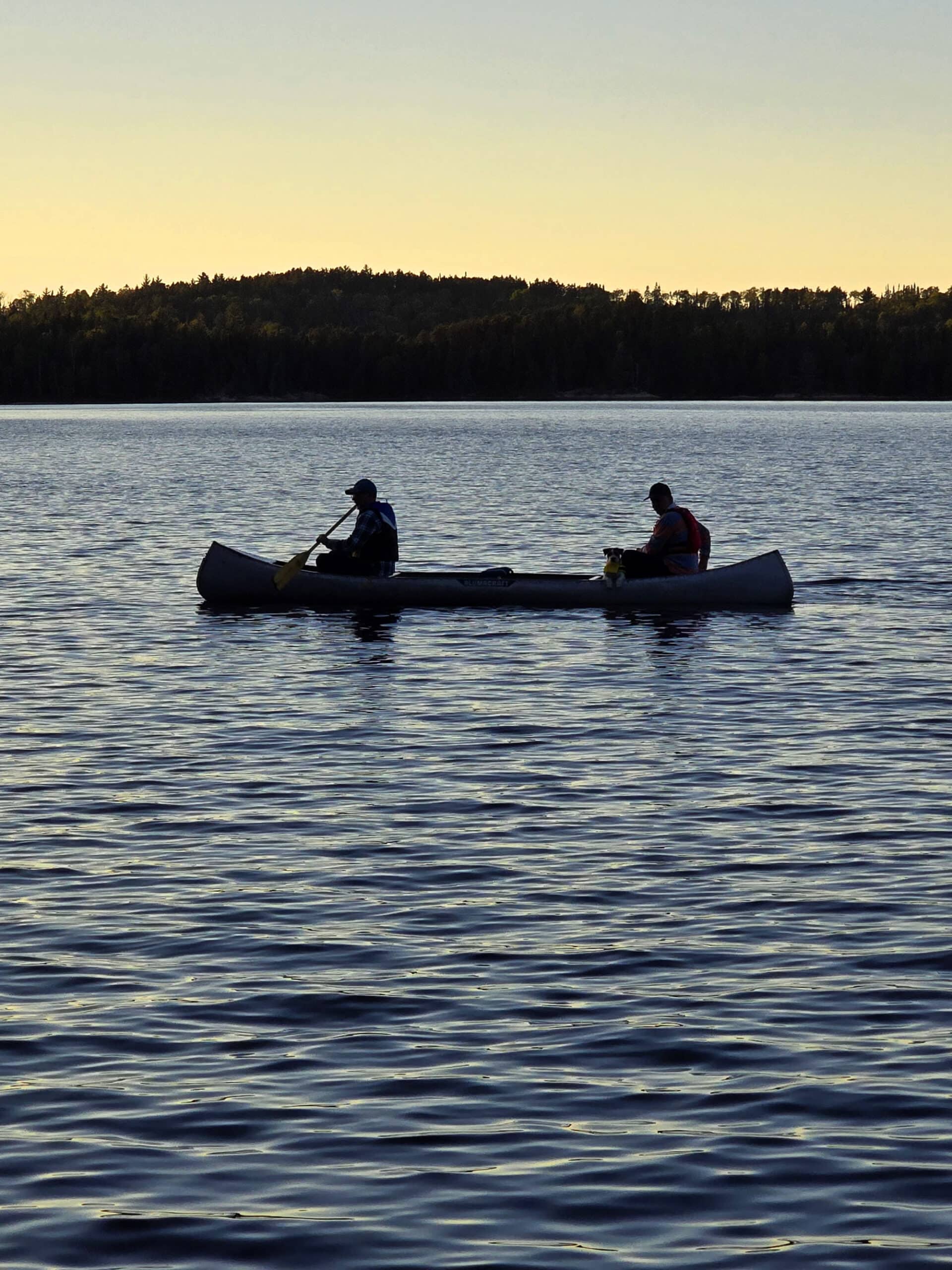
The campground rents out both kayaks and stand up paddleboards, and also loans out personal flotation devices and fishing gear.
The park website has a bunch of information on suggested canoe routes from each ranger station.
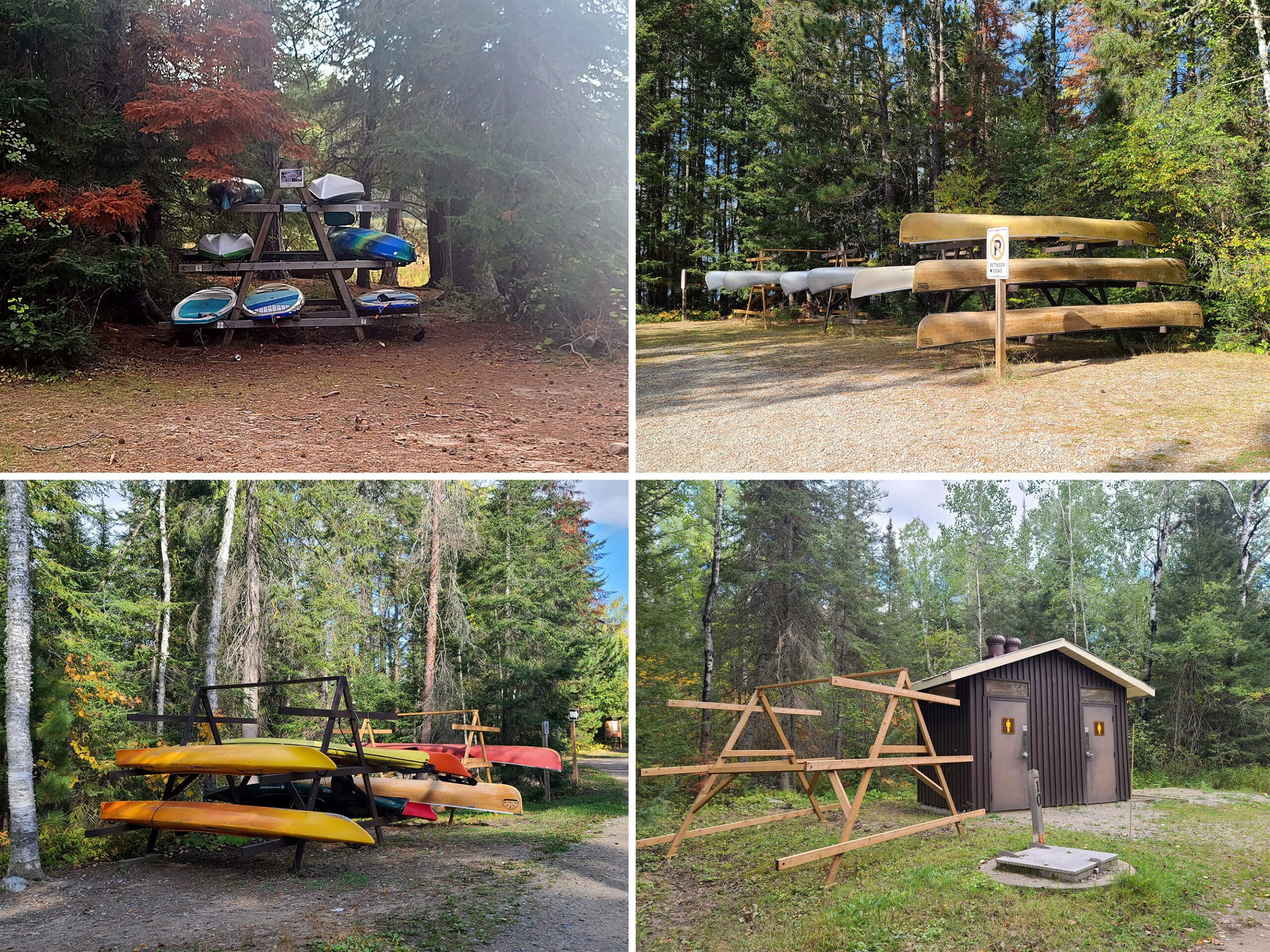
Fishing
The superb network of beautiful lakes in Quetico park are known to play host to some of the best fishing in Northern Ontario, with Lake Trout, Northern Pike, Smallmouth Bass, and Walleye being the focus.
There are some restrictions to keep in mind, though.
First off - obviously - you need a valid Ontario fishing license.
Beyond that, you can only use artificial bait, as both live bait and dead bait can bring unwanted and invasive species to park waters. These bait types include - but are not limited to - leeches, minnows, worms, etc.
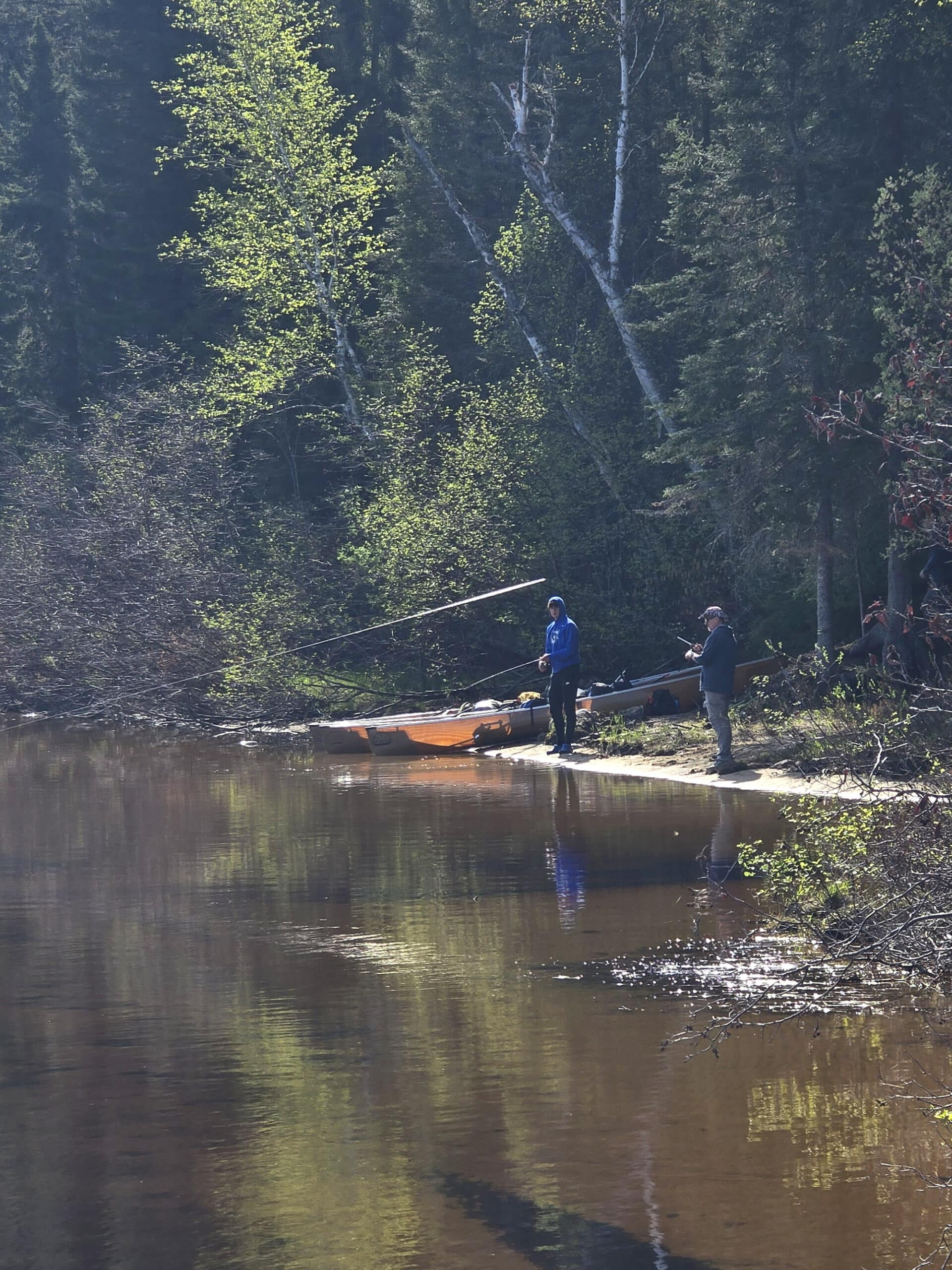
You can’t use motorized boats in Quetico, and you’re not permitted to store your watercraft - or equipment - anywhere in the park, without permission.
For those who need it, there is a fish cleaning station in the Ojibwa campground, near the beach.

Discovery Program
As with the other Ontario Provincial Parks we’ve visited, Quetico offers a Discovery Program during July and August.
One of the times, we’re going to have to go camping during the summer months, to see what these kinds of programs actually entail!
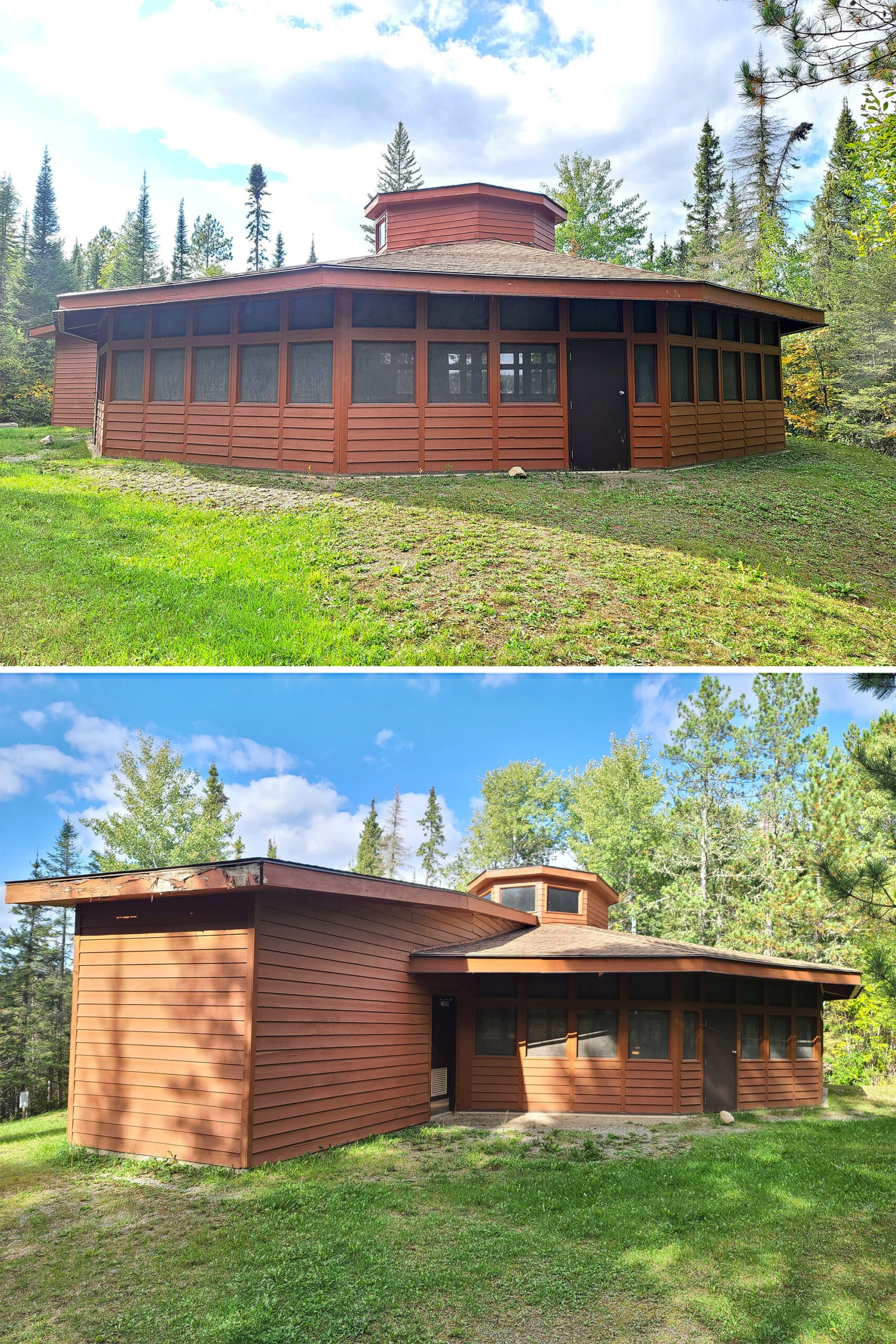
Winter Activities
Quetico offers a variety of activities for those willing to brave Northern Ontario winters.
Camping is available year round for backcountry campers, and limited campground camping is available from January 1 - March 31 in the Dawson Trail campgrounds.
Cross-Country skiing, snowshoeing, and Skijoring (A sport that combines cross country skiing with dogsledding) are available on the frozen lakes and waterways, as well as on the 15 km of groomed ski trails - both classic and skate - that are maintained in the Dawson Trail campground.
There are also several annual skiing events held in Quetico, such as the Sawmill Lake Classic Ski Tour, hosted by the Beaten Path Nordic Trails Ski Club.
Ice fishing for trout is available on the French Lake when it’s frozen over, though motorized augers and anything other than artificial lures with barbless hooks are not permitted.

Niantic Games
There are actually a fair number of stops throughout the park - a stop and a gym in Ojibwa, a couple stops in Chippewa, a few random stops along the main road, and a gym and a couple stops near the front gate.
Cell coverage was iffy, though, which definitely impacted play on our first trip. (I had very little trouble playing - would take a few attempts to log in, then be fine - my husband was absolutely unable to open his game, though.)
No problems at all on our second or third visit, though.

Final Thoughts
This campground really felt like every “Northern Ontario” thing I’ve ever seen, all rolled into one.
The air was clean and clear, it was very quiet - except for the loons calling out over the lake - and it really felt like a great way to get AWAY from everything.
Obviously this one will be special place for us on account of the northern lights, but also my personal family connection to the area.
The fact that my very first time seeing the northern lights happened at this particular park felt magical for more than one reason.
This campground is definitely on our list to come back to - even though we’re not into canoeing - next time we’re going to bring a telescope!
2024 Update: now that we’ve been back - but forgot to bring a telescope - we can definitely say that Quetico DOES NOT PLAY AROUND when it comes to Northern Lights!
I mean, damn.
Our second trip was even better than the first, and now we’re talking about possibly making this a twice/year thing!

More Northern Ontario Provincial Parks & Places to See
Want to read some more about the parks we've camped and at places we've seen in Northern Ontario? Here are some more posts!
Northern Ontario Campground Reviews:
Aaron Provincial Park
Agawa Bay Campground, Lake Superior Provincial Park
Blue Lake Provincial Park
Caliper Lake Provincial Park
Kakabeka Falls Provincial Park
Lake Superior Provincial Park
MacLeod Provincial Park
Neys Provincial Park
Ojibway Provincial Park
Pakwash Provincial Park
Pancake Bay Provincial Park
Pukaskwa National Park
Rabbit Blanket Lake, Lake Superior Provincial Park
Rainbow Falls Provincial Park
Rushing River Provincial Park
Sandbar Lake Provincial Park
Sioux Narrows Provincial Park
Sleeping Giant Provincial Park
White Lake Provincial Park
Northern Ontario Places to See:
Aguasabon Falls & Gorge
Amethyst Mine Panorama
Batchawana Bay
Chippewa Falls
Kakabeka Falls
Mink Creek Falls
Old Woman Bay
Ouimet Canyon Provincial Park
Potholes Provincial Park
Roy Wilson Suspension Bridge
Sand River Falls
Scenic High Falls
Temagami Fire Tower
Terrace Bay Beach
Want to explore beyond Northern Ontario? Check out our full list of Campground Reviews, Ontario Waterfalls, and other Places to See.
We also have a ton of Camping Recipes to cook up, while on your adventures!
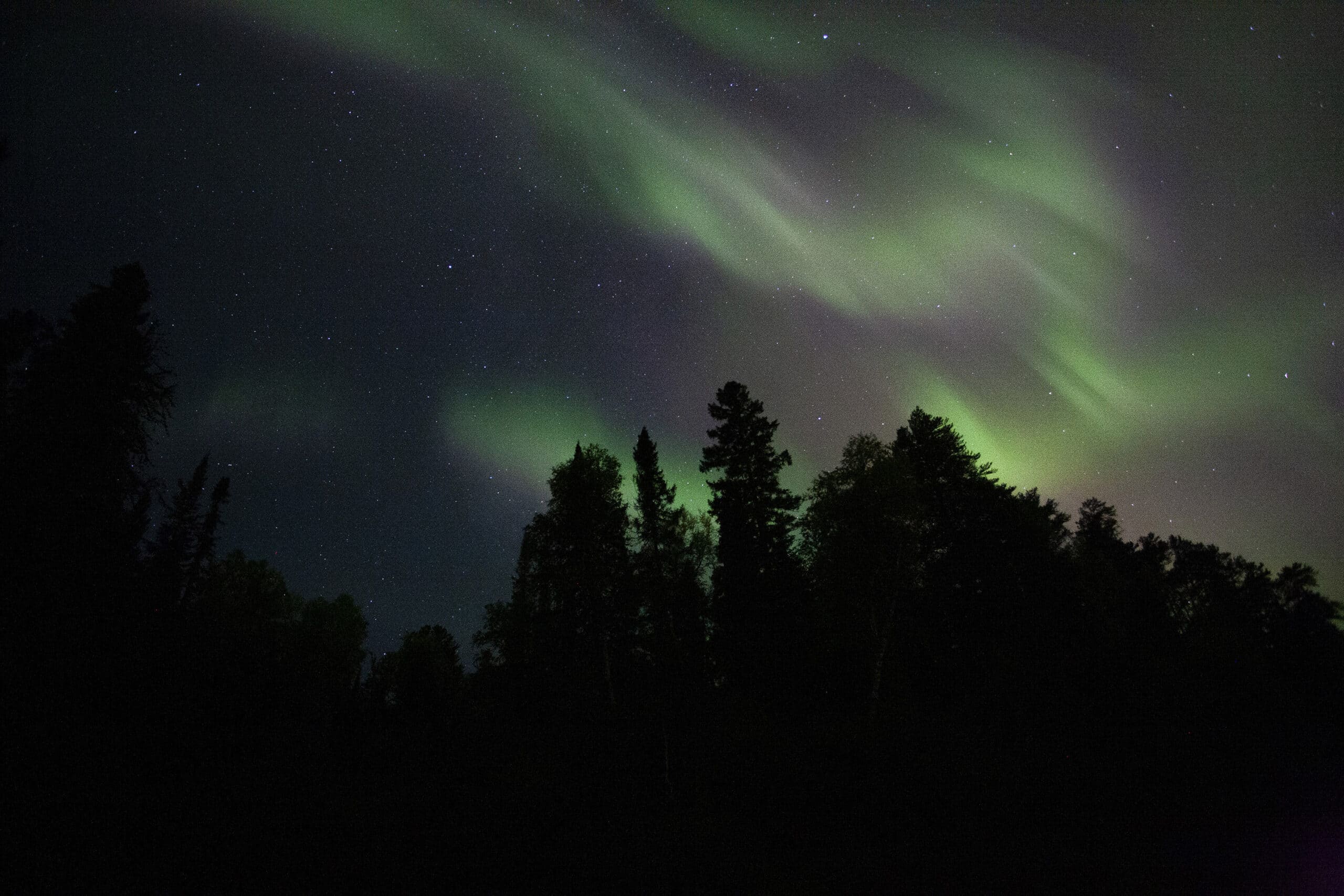
Thanks for Reading!If you loved this post - or have any questions about it - please leave a comment below! We'd also love it if you would consider sharing the link on social media! |
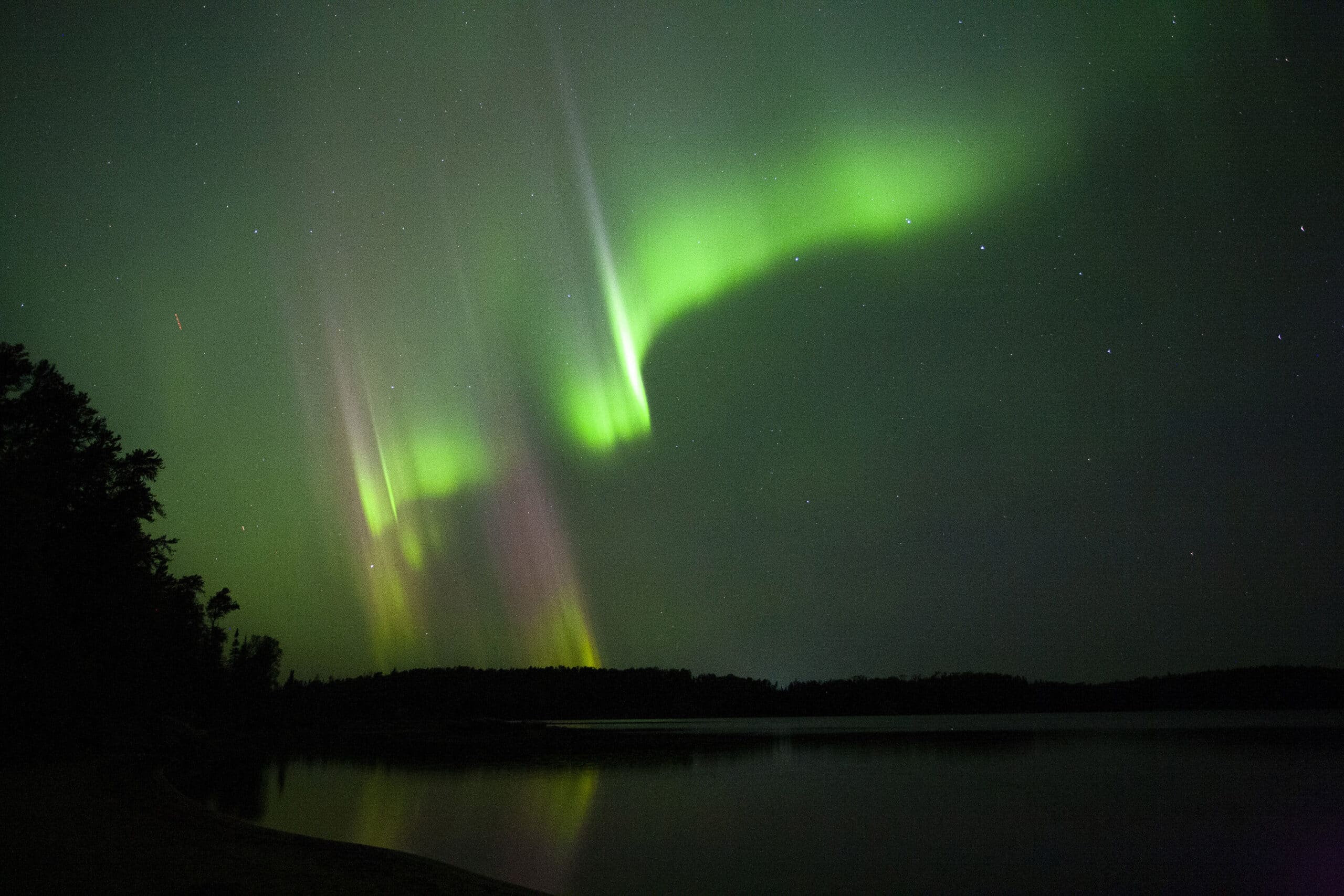



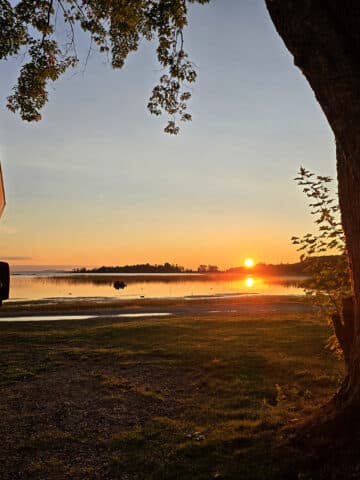
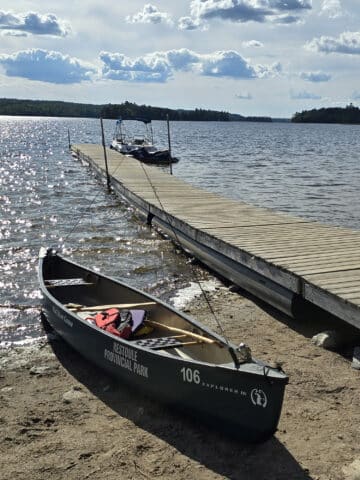


Anon
Hey! I work at Quetico PP and I absolutely loved reading your thoughts!! Thank you so much for putting the time and effort into this review. All of your information is super accurate! So glad you enjoyed